
- Registrazione

FIRE EVAC TOUR 2024
Fire evac tour 2024, come progettare un sistema di rivelazione e segnalazione allarme incendio in conformità alle normative vigenti. un caso pratico.
Nel corso del primo semestre 2024, Beta Cavi e Bosch Security Systems, saranno nuovamente sponsor nel consueto appuntamento di formazione e divulgazione delle normative antincendio. L’edizione 2024 del FIRE EVAC TOUR tratterà il tema della progettazione di un sistema di rivelazione e segnalazione allarme incendio secondo le attuali norme progettuali (UNI9795:2021, UNI ISO 7240-19:2010, UNI CEN/TS 54-32 e UE305:2011) applicando un approccio ingegneristico/progettuale innovativo immergendo il professionista in un vero e proprio caso reale. Analizzeremo insieme la progettazione di un campus universitario virtuale al cui interno sono stati progettati appositamente ambienti con condizioni e livello di rischio differente in modo da fornire una casistica la più completa possibile. Ciò permetterà al professionista di esaminare le soluzioni progettuali e impiantistiche più idonee da implementare evidenziando le variabili che possono ridurre l’efficacia del sistema stesso. Evento patrocinato dai principali Ordini.
L’iscrizione è gratuita e l’evento è a numero chiuso pertanto la registrazione è obbligatoria.
- Affronteremo problematiche e criticità della progettazione dei sistemi antincendio e dei sistemi di evacuazione vocale
- Esamineremo gli ambienti specifici analizzando quali parametri debbano essere considerati per fornire la soluzione più consona.
- Analizzeremo gli aspetti progettuali fondameli tra cui: intellegibilità, rivelazione in situazioni critiche, condizioni ambientali di utilizzo,…
- I cavi avranno un ruolo fondamentale nel garantire l’interoperabilità tra gli apparati, pertanto esamineremo norme progettuali di riferimento, condizioni di posa, responsabilità civili e penali, principali cause di malfunzionamento del sistema derivanti da una scelta tecnica errata…
09:00 Registrazione partecipanti
09:30 inizio lavori, 1. sistemi di allarme vocale: elementi di progettazione., 2. le scelte progettuali per i sistemi di rivelazione incendio., 3. linee di interconnessioni., 13:00 chiusura lavori, alla fine dell’evento saluto dei relatori e distribuzione materiale divulgativo., nelle tappe di roma, bari, lecce e cagliari gli eventi si terranno il pomeriggio con il seguente orario: inizio 14.30, fine 18.30.

Andrea Barbieri
Andrea Barbieri ha conseguito la laurea in Ingegneria Elettronica presso il Politecnico di Milano. Fin dalla prima esperienza lavorativa, ha operato nel settore Safety&Security, maturando un’importante esperienza nel settore Rivelazione Incendio dove ha ricoperto diversi ruoli: dal supporto pre-post vendita alla gestione Prodotti/ Marketing e Sales. Responsabile per supporti normativi e progettuali verso studi di progettazione e System Integrator.

Luca Galli Membro UNI Sistemi automatici rivelazione incendi CEN/TC72

Ing. Andrea Moneta Andrea Moneta ha conseguito la laurea in Ingegneria Informatica presso il Politecnico di Milano, fin dalla prima esperienza lavorativa ha operato nel settore della sicurezza maturando un’importante esperienza nel settore della rivelazione e segnalazione allarme incendio. Partecipa attivamente alla scrittura dei testi normativi presso i vari enti nazionali e supporta normativamente gli studi tecnici d’ingegneria e i e System Integrator al fine di identificare la soluzione più consona al caso specifico. Membro UNI Working Group CEN/TC34 Membro CEI TC 46 e TC 20 Membro del GL FIRE – EVAC di ANIE Sicurezza

Claudio Scaravati
Claudio Scaravati si occupa di sistemi Audio e A/V da circa 30 anni. Già membro di Audio Engineering Society, in passato ha seguito diversi progetti internazionali di normative Audio e di impiantistica di Emergenza. Membro del GL di FIRE -EVAC di ANIE Sicurezza. Membro del CT-79 di CEI.

Alessio Sirini
Alessio Sirini opera nel mondo safety & security da oltre 20 anni, supportando e proponendo soluzioni applicative a tutti i soggetti interessati del settore per i sistemi Rivelazione Incendio, Antintrusione e Controllo Accessi. In particolare, garantisce supporto agli studi tecnici d’ingegneria a livello di scelte progettuali in riferimento alle normative vigenti per la rivelazione incendio.
15 date, 15 eventi in tutta ITALIA, questo è il FIRE EVAC TOUR 2024.
Di seguito il calendario delle date:
Clicca sulla data prescelta per conoscere i dettagli dell’evento.
Calendario Date
Milano 12 febbraio.
Auditorium BOSCH via M.A. Colonna, 35 Milano posti disponibili 140 (iscrizioni chiuse) inizio ore 9.00 locandina Milano
Brescia 13 Febbraio
Double Tree Hilton Viale Europa, 45 Brescia posti disponibili 100 inizio ore 9.00 locandina Brescia
Mantova 14 Febbraio
Hotel La Favorita Via S. Cognetti de Martiis, 1 Mantova posti disponibili 50 inizio ore 9.00 locandina Mantova
Udine 27 Febbraio
Istituto Salesiano – Centro di Formazione Professionale BEARZI Via don Bosco, 2 Udine posti disponibili 250 inizio ore 9.00 locandina Udine
Mestre 28 Febbraio
Centro di Formazione San Marco Via dei Salesiani, 15 Mestre posti disponibili 378 inizio ore 9.00 locandina Mestre
Verona 29 Febbraio
Centro di Formazione San Zeno Via don Minzoni, 50 Verona posti disponibili 140 inizio ore 9.00 locandina Verona
Cuneo 12 Marzo
ALBERGO DELL’AGENZIA Via Fossano, 21 Pollenzo Bra posti disponibili 200 inizio ore 9.00 locandina Cuneo
Torino 13 Marzo
Istituto Salesiani Sede Torino Valdocco Via Maria Ausiliatrice, 32 Torino posti disponibili 150 inizio ore 9.00 locandina Torino
Novara 14 Marzo
Phenomenon SP229, 10, 28010 Fontaneto D’agogna NO posti disponibili 500 inizio ore 9.00 locandina Novara
Lecce 9 Aprile
Arthotel&Park Via Giorgio De Chirico, 1 73100 LECCE posti disponibili 220 Evento pomeridiano inizio 14.30 locandina Lecce
Bari 10 Aprile
Parco dei Principi Hotel Congress & Spa Via Vito Vasile, 3 prolungamento Viale Europa 6 Bari posti disponibili 300 Evento pomeridiano inizio 14.30 locandina Bari
Roma 7 Maggio
Auditorium Salesiani Via Prenestina, 468 00171 Roma posti disponibili 220 Evento pomeridiano inizio 14.30 locandina Roma
Cagliari 8 Maggio
Università di Cagliari Facoltà di Ingegneria Aula Z Via Marengo 2 09124 Cagliari posti disponibili 170 Evento pomeridiano inizio 14.30 locandina Cagliari
Firenze 22 Maggio
Auditorium Al Duomo Via de’ Cerretani 54/R Firenze posti disponibili 100 inizio ore 9.00 locandina Firenze
Pisa 23 Maggio
CNR Via Giuseppe Moruzzi, 56124 Pisa posti disponibili 300 inizio ore 9.00 locandina Pisa
Registrazione Fire Evac Tour 2024
Crediti Formativi Professionali (CFP) richiesti agli Ordini e Collegi professionali della Provincia di competenza e in attesa di riconoscimento. (Vedi dettaglio nella locandina allegata nella singola tappa)
- Dichiaro di accettare la raccolta dati e le finalità sulla protezione dei dati personali in base al Regolamento Ue 2016/679, noto come GDPR (General Data Protection Regulation)

- AMMINISTRAZIONE TRASPARENTE
- FONDAZIONE DELL’ORDINE DEGLI INGEGNERI
- ORDINI INGEGNERI ITALIANI

ORDINE DEGLI INGEGNERI
Della provincia di torino.
- EVENTI E SEMINARI GRATUITI
Fire Evac Tour 2024
Data: 26 Febbraio 2024
Tempo di lettura: 3 min
Organizzato dall’Ordine degli Ingegneri di Torino, in collaborazione con il CNPI e con l’Associazione FirePRO, è stato riconosciuto valido per la Formazione Continua dell’Ingegnere il seminario dal titolo
“ Fire Evac Tour 2024: Un’esperienza totalmente immersiva nel progetto “
L’evento, a carattere gratuito, si terrà a partire dalle ore 9.30 del 13 marzo 2024 presso CNOS-FAP Torino Valdocco (Via Maria Ausiliatrice, 36 – Torino ).
Scarica programma

- Patentino FGAS
- Lavora con noi
Seminari Fire Evac Tour 2024 a Bari e Lecce
- Seminari Fire Evac Tour 2024…

Seminari Fire Evac Tour 2024:
LECCE, 9 aprile 2024 ARTHOTEL & PARK LECCE via G. De Chirico, 1 – Uscita 10 tang.est/ovest, Lecce ore 14.00-19.00 Programma FIRE EVAC TOUR Lecce
BARI, 10 aprile 2024 PARCO DEI PRINCIPI – HOTEL CONGRESS & SPA Via Vito Vasile, prolungamento Viale Europa 6 – Bari (BA) ore 14.00-19.00 Programma FIRE EVAC TOUR Bari
Autore: SmartFaber
Related posts.

Privacy Overview
Fire Evac Tour Evo 2016

Fire Evac Tour Evo is the event dedicated to fire prevention . During the first quarter of 2016, Beta Cavi and Bosch Security Systems will once again be sponsors for the customary fire prevention training and awareness event. The 2016 edition of FIRE EVAC TOUR EVO was conceived to remove any possible doubt on designing fire prevention systems but this time with the help of multimedia systems.
The idea is for users to have a unique multimedia experience by taking the professional “ inside the project ” in order to experience all of the design phases personally in 3D. In fact, during the speeches of the various Committee Members , the project will take form and develop step by step.
This is what you will be presented with: • We will develop the project together • We will take you “inside the project” with a multimedia experience • We’ll discuss problems and critical issues of fire prevention system design • Cables will play a fundamental role in ensuring interoperability between the devices FIRE EVAC TOUR EVO will, as usual, be sponsored by the major Orders and participants will be able to claim educational credits.
Calendar dates: 22 February Milan at the Robert Bosch S.p.a. Auditorium located on via Marcantonio Colonna No. 35 (point of contact Laura Croci) 24 February Bolzano at the Parkhotel Laurin located on via Laurin No. 4 (point of contact Nicole Hofer) 25 February Udine at Hotel La dì Moret located on viale Tricesimo No. 276 (point of contact Yos Ellero) 26 February Padua at Hotel Galileo located on via Venezia No. 30 (point of contact Cristina Colombo) 2 March Bologna at Hotel Savoia Regency located on via del Pilastro No. 2 (point of contact Stefania Marangon) 3 March Montecatini Terme (PT) at Teatro Verdi 8 March Rome at Hotel Bellambriana located on via Luca Passi No. 6 (point of contact Simonetta Pietrobon) 9 March Bari at Hotel Majesty located on via Gentile No. 97/B (point of contact Michaela Colella)
To register: www.fire-evac-tour.com/en/
by the Editorial Staff

Peter Mita, Honeywell Fire, new Euralarm President

International Team EL.MO.: Integration of tailored systems and solutions

EPBD creates fire safety and security challenges too

EUROSATORY: there can be no sustainable world without peace and security

i-PRO: Gerard Figols as Chief Product Officer

Carlos Perez: new Technical Manager Euralarm for Fire and Extinguishing

Securex South Africa

Eurosatory 2024

Security Essen

Anticipate London
Latest videos from our channel.

AxxonSoft and Axxon One 2.0 at Sicurezza in Milan. Interview with Alan Ataev, AxxonSoft CEO

PASO 1973 – 2023, 50 years of excellence: interview with Ofir Samoray, TELETONE Israel

PASO and its 50 years of excellence. The event on Lake Maggiore
S News S.r.l. Via Trieste, 6 36061 Bassano del Grappa (VI) Tel. / Fax. (+39) 0424 383049 [email protected]
VAT 03757700244 R.E.A. : VI 351393 Registered capital of € 20.000 fully paid up.
Privacy Policy - Cookie Policy ©2024 Tutti i diritti riservati.
- Accumulators, Batteries
- Fire and Gas Detection
- Intrusion Detection, Perimeter Protection
- Associations, Institutions
- Cables and Wires
- Consultants, Designers, Professionals
- Access Control
- Cybersecurity
- Sound Broadcasting, Evac
- Distributors, Systems Integrators
- Smart Buildings, Bms, Automation
- Intelligence & Security
- Video Surveillance, Vms
- Private Security, Public Safety
S NewsLetter
Stay up to date on the latest security news.
- Top Stories
- Listen Live
- ArizonaSports.com
Arizona News
- Arizona Sports
- Arizona Business
- Arizona Votes
- Arizona Immigration
- Arizona Education
- Arizona Health
- Arizona Traffic
- Arizona Weather
- East Valley Youth Violence
- Arizona Technology
- Arizona Wildfires
- Community Spotlight
Sponsored Articles
- Arizona's Morning News
- The Mike Broomhead Show
- The Ramsey Show
- The Chris and Joe Show
- Outspoken with Bruce and Gaydos
- The Chad Benson Show
- Complete Lineup
- Silent Witness
- Rosie on the House
- Chew On This
- Data Doctors
- Kim Komando Tech Tips
- On-Air Schedule
- Staff Social Media
- Contests and Events
- Text Alerts
- Everyday Strong
ARIZONA NEWS
Simmons Fire evacuation orders lifted 3 days after blaze started in Pinal County
Jun 1, 2024, 11:03 AM | Updated: 11:09 am
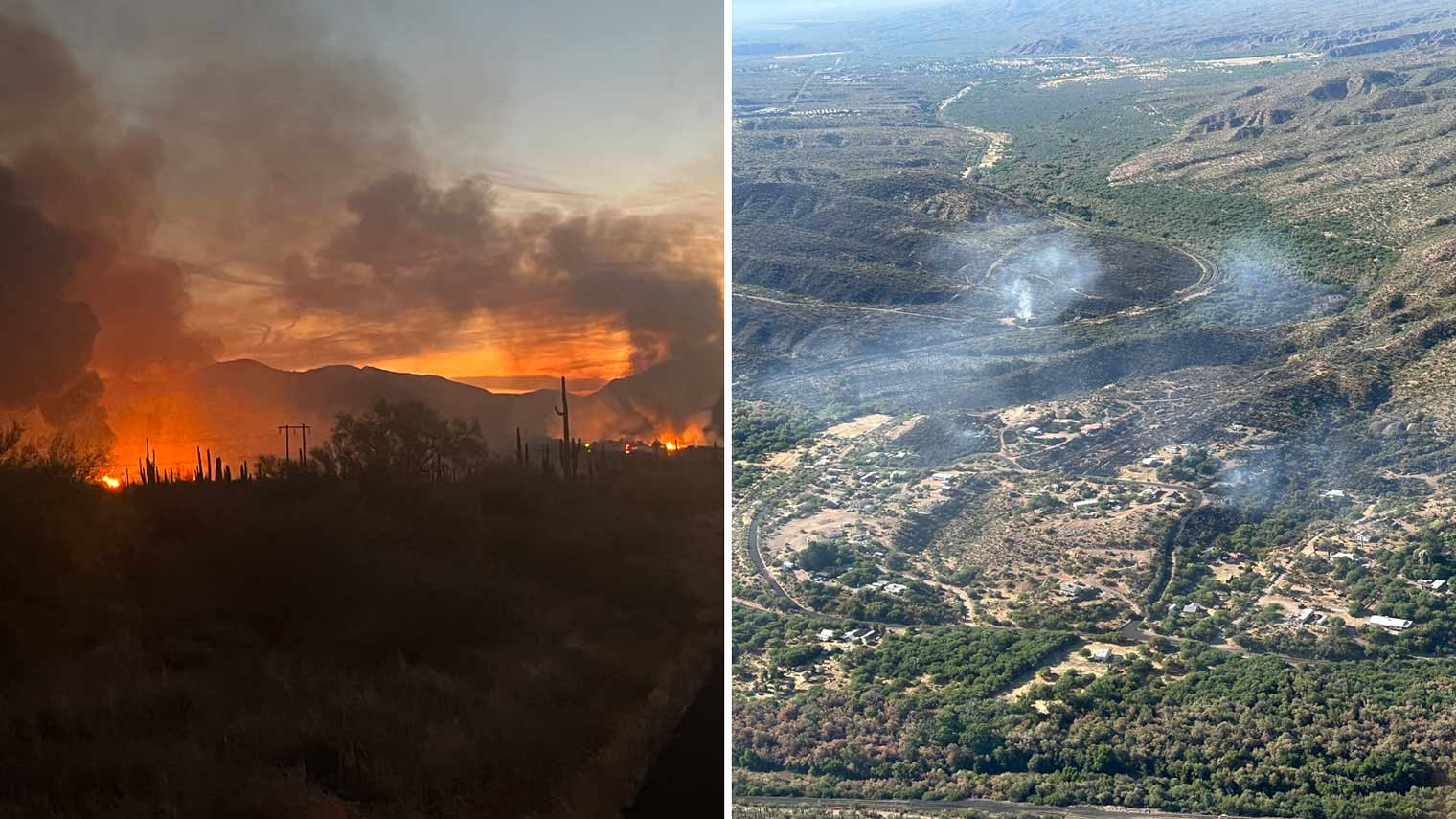
At least two structures were destroyed overnight by the Simmons Fire, a wildfire that started Tuesday, May 28, 2024, near the Arizona town of Kearny and prompted evacuations. (X Photo/@PinalCSO, left, and KTAR News Photo/Troy Barrett)
(X Photo/@PinalCSO, left, and KTAR News Photo/Troy Barrett)

BY KTAR.COM
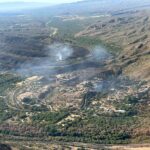
PHOENIX – Crews battling Arizona’s Simmons Fire are at 85% containment as of Saturday morning, with no growth reported for the second straight night.
Authorities lifted evacuation orders for the Simmons Fire on Friday morning, three days after residents near the wildfire were told to leave their homes.
The wildfire started about 4½ miles northwest of Kearny around 5:20 p.m. Tuesday, and the evacuation orders were issued by the Pinal County Sheriff’s Office about an hour later.
The Riverside neighborhood outside of Kearny was put on GO status in the state’s emergency notification system , and other nearby homes were told to be prepared to evacuate (SET status).
In total, about 50 residences were in either GO or SET status until the Simmons Fire evacuation orders were lifted Friday morning.
The previous "Go-Evacuate" status for the Riverside neighborhood, and the "Set-Be Alert" status for residents south of the Riverside neighborhood down to Kearny city limits have both been downgraded to "Ready" status. All residents may return to their homes. #simmonsfire pic.twitter.com/zWSNmCm88b — Pinal County Sheriff’s Office (@PinalCSO) May 31, 2024
How much damage did Simmons Fire do?
The Simmons Fire has been mapped at 351 acres. After a productive day of firefighting Thursday, it was 51% contained as of Friday morning, officials said.
RELATED STORIES
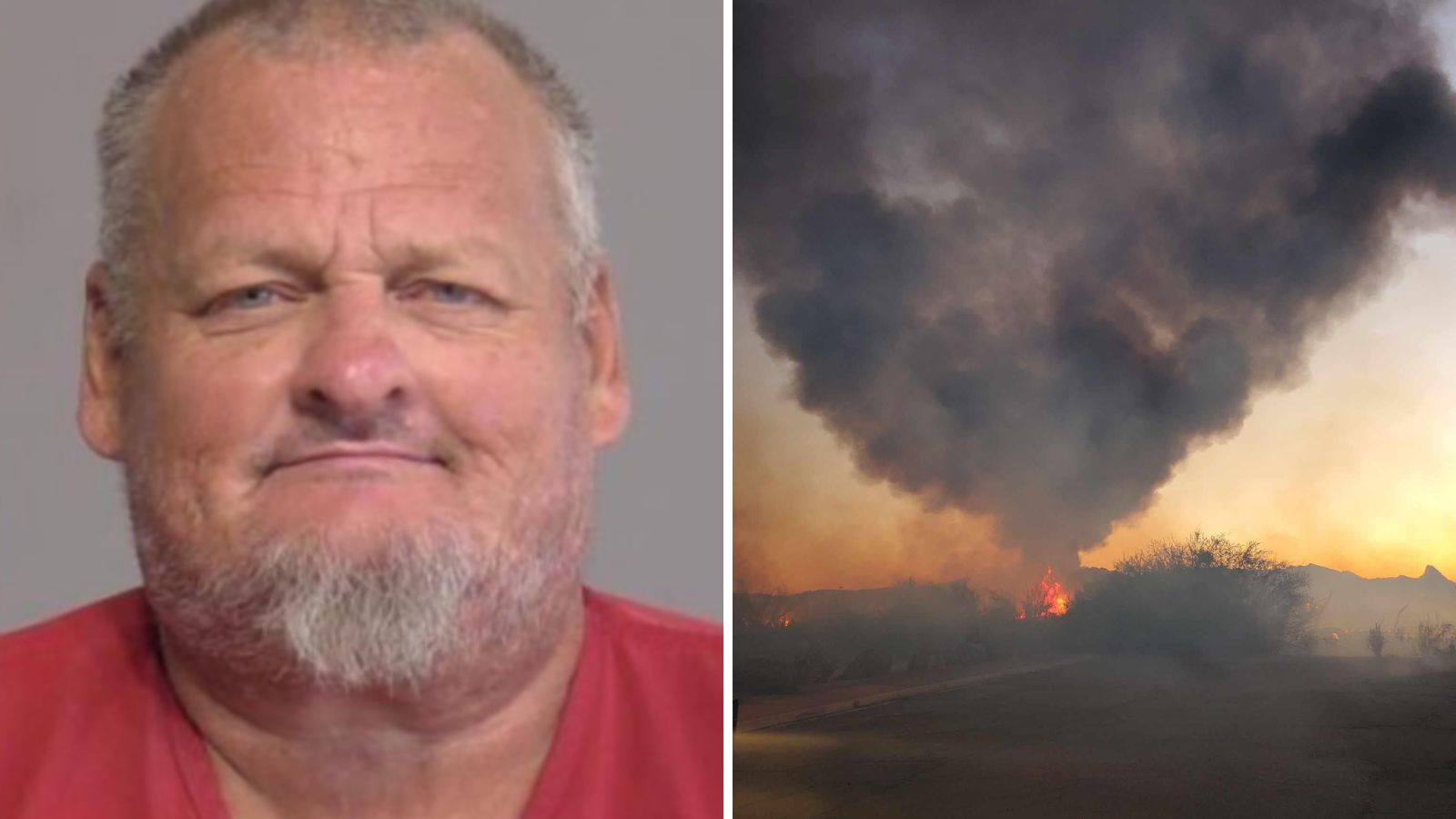
Arizona man accused of starting fire in wildlife refuge near California border
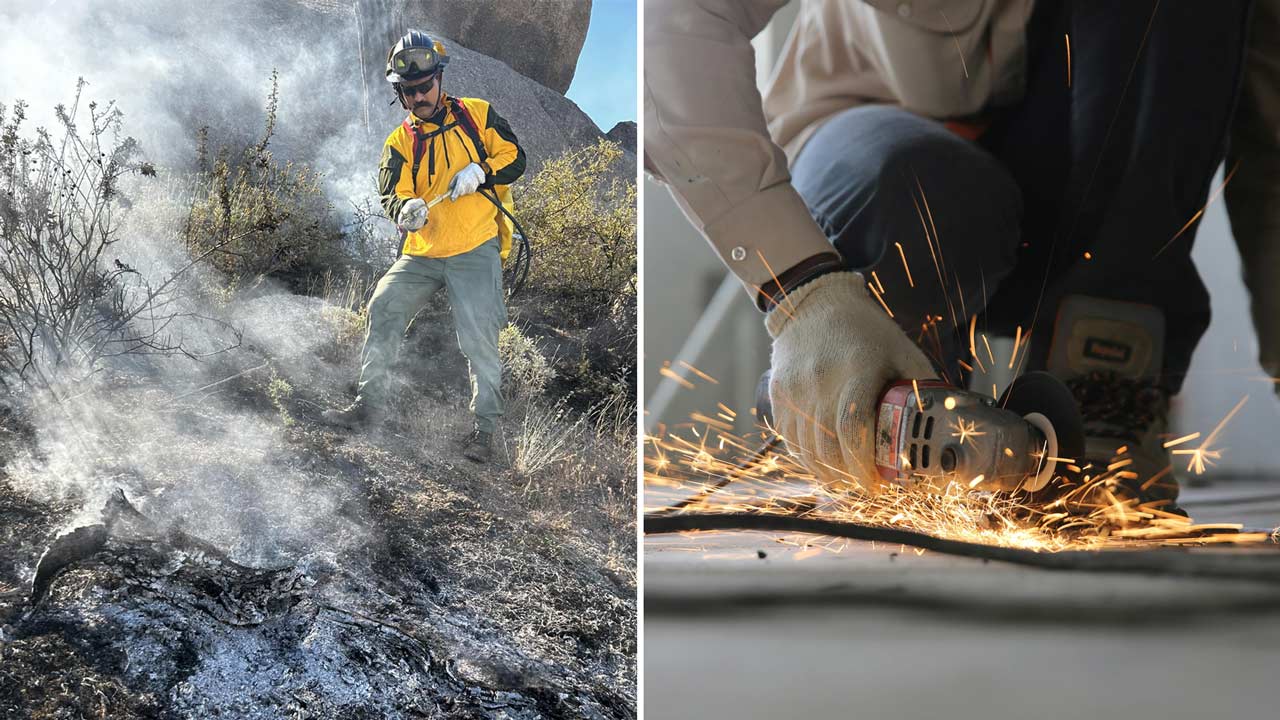
Valley firefighters to construction crews: 'Please stop starting brush fires'
However, the blaze destroyed four structures and damaged five others before firefighters gained the upper hand.
On Thursday night, officials said the power could be restored north of Kearny. The power had been turned off during the incident for the safety of firefighters and the public.
As of Friday evening, nearly 160 personnel were still assigned to the incident.
The cause of the Simmons Fire is unknown.
Kearny is located off State Route 177 between Superior and the Hayden-Winkelman area, about 85 miles southwest of downtown Phoenix.
This is an updated version of a story originally published May 28, 2024.
We want to hear from you.
Have a story idea or tip? Pass it along to the KTAR News team here .

Pedestrian dies after being hit by vehicle in Phoenix early Saturday
Police are investigating a deadly collision that occurred between a pedestrian and a vehicle in Phoenix early Saturday.
60 minutes ago

Overnight stabbing leaves one dead, one in jail
Police responded to the area of 27th Avenue and Indian School Road regarding a stabbing and arrested a suspect.
3 hours ago

Pilot of small aircraft killed in crash at Picacho Peak State Park
A man piloting a small aircraft was killed when the plane crashed near the top of Picacho Peak on Saturday morning.
4 hours ago

US 60 reopened after crash closed lanes in both directions near Superior
US 60 was reopened near Superior after a crash closed the highway in both directions late Saturday morning, ADOT announced.
5 hours ago

Glendale expands water conservation rebate program
The City of Glendale is expanding its water conservation rebates with a focus on landscaping, toilets and washing machines.

Scottsdale Fashion Square to host blood drive on Monday
Working in conjunction with the American Red Cross, the Scottsdale Fashion Square shopping center will host a blood drive on Monday, June 10.
7 hours ago

Midwestern University
Midwestern University Clinic visits boost student training & community health
Going to a Midwestern University Clinic can help make you feel good in more ways than one.

Sanderson Ford
3 new rides for 3 new road trips in Arizona
It's time for the Sanderson Ford Memorial Day sale with the Mighty Fine 69 Anniversary, as Sanderson Ford turned 69 years old in May.

DESERT INSTITUTE FOR SPINE CARE
Desert Institute for Spine Care is the place for weekend warriors to fix their back pain
Spring has sprung and nothing is better than March in Arizona. The temperatures are perfect and with the beautiful weather, Arizona has become a hotbed for hikers, runners, golfers, pickleball players and all types of weekend warriors.

An official website of the United States government.
Here’s how you know
The .gov means it’s official. Federal government websites often end in .gov or .mil. Before sharing sensitive information, make sure you’re on a federal government site.
The site is secure. The https:// ensures that you are connecting to the official website and that any information you provide is encrypted and transmitted securely.
Occupational Safety and Health Administration
- 中文(简体) (Chinese-Simplified)
- 繁體中文 (Chinese-Traditional)
- Kreyòl ayisyen (Haitian Creole)
- 한국어 (Korean)
- Español (Spanish)
- Filipino/Tagalog
- Tiếng Việt (Vietnamese)
- Emergency Preparedness and Response
Emergency Preparedness and Response: Getting Started
General business preparedness for general, construction and maritime industries, evacuation & shelter-in-place, osha’s role in emergency response, ppe for emergency response and recovery workers, introduction.
Emergencies and disasters can strike anywhere and at any time bringing workplace injuries and illnesses with them. Employers and workers may be required to deal with an emergency when it is least expected and proper planning before an emergency is necessary to respond effectively.
This webpage is designed to help workers and employers plan for that possibility. The best way to protect workers is to expect the unexpected and to carefully develop an emergency action plan to guide everyone in the workplace when immediate action is necessary. Planning in advance helps ensure that everyone knows what to do when an emergency occurs.
What is a workplace emergency?
A workplace emergency is a situation that threatens workers, customers, or the public; disrupts or shuts down operations; or causes physical or environmental damage. Emergencies may be natural or man-made, and may include hurricanes, tornadoes, earthquakes, floods, wildfires, winter weather, chemical spills or releases, disease outbreaks, releases of biological agents, explosions involving nuclear or radiological sources, and many other hazards. Many types of emergencies can be anticipated in the planning process, which can help employers and workers plan for other unpredictable situations.
The Emergency Preparedness and Response landing page provides a listing of all of the specific hazards for which the Agency currently has information available on its website, as well as links to general emergency preparedness and response guidance.
What are OSHA's requirements for emergencies?
Some key OSHA requirements for emergencies can be found in the following sections of standards for general industry ( 29 CFR 1910 ), construction ( 29 CFR 1926 ), and maritime ( 29 CFR 1915 , 1917 , and 1918 ). The table may not list all standards that apply to all situations.
The following table is best viewed on a tablet or pc.
Additional OSHA standards may apply. The OSHA Law & Regulations web page provides a complete list of OSHA standards by industry.
What other OSHA standards address emergency planning requirements?
Several OSHA standards address emergency planning requirements, including 29 CFR 1910.38 ; 29 CFR 1926.35 ; Hazardous Waste Operations and Emergency Response (HAZWOPER) ( 29 CFR 1910.120(q) ); Fire Brigades ( 29 CFR 1910.156 ); and Permit-Required Confined Spaces ( 29 CFR 1910.146(k) , 29 CFR 1926.1211). OSHA Publication 3122, Principal Emergency Response and Preparedness Requirements in OSHA Standards and Guidance for Safety and Health Problems , provides a broad overview of emergency planning requirements in OSHA standards.
Employers should also be familiar with the consensus standards of the National Fire Protection Association (NFPA) , American National Standards Institute (ANSI) , and other standards-setting organizations, as these may provide additional recommendations and requirements about emergency planning. The NFPA develops, publishes, and disseminates hundreds of consensus codes and standards intended to minimize the possibility and effects of fire and other risks. Virtually every building, process, service, design, and installation in society today is affected by NFPA documents. NFPA codes and standards are adopted and used throughout the world. For more information about NFPA and their codes and standards, visit their website at www.nfpa.org .
What is an emergency action plan?
An emergency action plan (EAP) is intended to facilitate and organize employer and worker actions during workplace emergencies and is recommended for all employers. Well-developed emergency plans and proper worker training (i.e., so that workers understand their roles and responsibilities within the plan) will result in fewer and less severe worker injuries and less damage to the facility during emergencies. A poorly prepared plan may lead to a disorganized evacuation or emergency response, resulting in confusion, injury, illness (due to chemical, biological and/or radiation exposure), and/or property damage.
Two OSHA standards ( 29 CFR 1910.38(a) and 29 CFR 1926.35 ) require written EAPs. Not all employers are required to establish an EAP (see section titled "Am I required to have an Emergency Action Plan (EAP)" to see if your business is required), but developing an EAP is a good way to protect workers and businesses during an emergency. Emergency preparedness is a well-known concept in protecting workers' safety and health.
Putting together a comprehensive emergency action plan involves conducting a hazard assessment to determine what, if any, physical or chemical hazards inside or from outside the workplaces could cause an emergency. The plan should describe how workers will respond to different types of emergencies, taking into account specific worksite layouts, structural features, and emergency systems. If there is more than one worksite, each site should have an emergency action plan.
Most organizations find it beneficial to include a diverse group of representatives (management, workers, local health departments and agencies, and public safety officials/members) in this planning process and to meet frequently to review progress and allocate development tasks. Outside representatives from federal, state and local agencies may be able to assist organizations with incorporating other requirements or guidelines into their EAPs. The commitment and support of all workers and employers is critical to the plan's success in the event of an emergency; ask for worker input in developing and implementing an EAP. For smaller organizations with 10 or fewer workers, the plan does not need to be written and may be communicated orally (General Industry Standard - 29 CFR 1910.38(b) , Construction Industry Standard - 29 CFR 1926.35(e)(3) ).
Am I required to have an Emergency Action Plan (EAP)?
Workplaces covered by the following standards may be required to have an EAP :
- Process Safety Management of Highly Hazardous Chemicals (in general industry, 29 CFR 1910.119 ; in construction, 29 CFR 1926.64 )
- Fixed Extinguishing Systems, General ( 29 CFR 1910.160 )
- Fire Detection Systems ( 29 CFR 1910.164 )
- Grain Handling ( 29 CFR 1910.272 )
- Ethylene Oxide ( 29 CFR 1910.1047 )
- Methylenedianiline (in general industry, 29 CFR 1910.1050 ; in construction, 29 CFR 1926.60 )
- 1,3-Butadiene ( 29 CFR 1910.1051 )
Under OSHA's fire extinguisher standard, 29 CFR 1910.157 , an EAP is required if the employer:
- wishes to comply with only paragraphs (e) and (f) of the standard when providing extinguishers that are not intended for employee use, or
- when the employer does not provide extinguishers and intends to totally evacuate the workplace on the sounding of the fire alarm.
If you are still unsure about whether you are required to have an EAP, use OSHA's Expert System to help you determine your EAP requirements.
At a minimum, for businesses that are required to have an emergency action plan (EAP), the plan must include:
- A preferred method and/or procedures for reporting fires and other emergencies ( 29 CFR 1910.38(c)(1) and 29 CFR 1926.35(b)(5) );
- Emergency escape procedures and route assignments, such as floor plans, workplace maps, and safe or refuge areas (example shown below) ( 29 CFR 1910.38(c)(2) and 29 CFR 1926.35(b)(1) );
- Procedures to account for all workers after an evacuation, such as designating an assembly location (e.g., a safe/refuge area) (29 CFR 1910.38(b)(4) and 29 CFR 1926.35(b)(3));
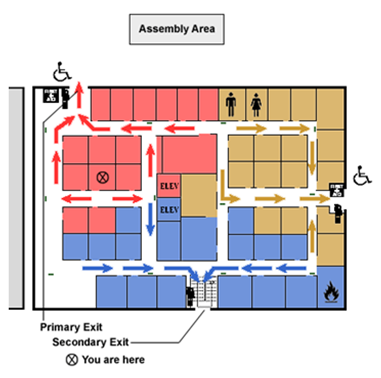
- Names, titles, departments, and telephone numbers of individuals both within and outside the company to contact for additional information or explanation of duties and responsibilities under the emergency plan ( 29 CFR 1910.38(c)(6) and 29 CFR 1926.35(b)(6) );
- Procedures for workers who remain to perform or shut down critical plant operations, operate fire extinguishers, or perform other essential services that cannot be shut down for every emergency alarm before evacuating ( 29 CFR 1910.38(c)(3) and 29 CFR 1926.35(b)(2) ); and
- Rescue and medical duties for any workers designated to perform them ( 29 CFR 1910.38(c)(5) and 29 CFR 1926.35(b)(4) ).
In addition, although not specifically required by OSHA's EAP standard, other emergency preparedness actions include:
- Posting emergency numbers in the workplace for the fire brigade, fire department, and other appropriate emergency responders;
- Inviting external emergency responders to tour the facility to learn about hazards, the facility’s processes, protective features and systems, and proper actions to take (or not to take) during emergencies. Tours should account for different shifts of firefighters;
- Coordinating tours for volunteer firefighters at times that accommodate their work schedules;
- Arranging training drills for responders and facility personnel to practice emergency procedures together;
- Designating a facility liaison to coordinate with emergency responders and keep them updated if hazards or processes change;
- Designating one or more emergency contact persons that are knowledgeable of the facility’s hazards and processes and ensure their contact information is quickly accessible during emergencies;
- Designating staff responsible to inventory and maintain emergency equipment and supplies;
- Including a description of the alarm system in the emergency plan to be used to notify workers (including disabled workers) to evacuate and/or take other actions. The alarms used for different actions should be distinctive and might include horn blasts, sirens, or even public address systems;
- Identifying the site of an alternative facility for communications to be used in the event the primary facility is inaccessible because of emergencies, such as a fire or explosion; and
- Storing original or duplicate copies of accounting records, legal documents, worker emergency contact lists, building plans, HAZMAT lists, and other essential records at a secure on-site or off-site location.
How to alert workers of an emergency?
If a business is required to have an EAP, the plan must include a way to alert workers, including disabled workers, to evacuate or take other action (see 29 CFR 1910.38(d) and 29 CFR 1926.35(c) ). These standards require:
- Employers to ensure that alarms are distinctive and recognized by all workers as a signal to evacuate the work area or perform actions identified in the plan; and
- Alarms to be able to be heard, seen, or otherwise perceived by everyone in the workplace. Local fire codes require an auxiliary power supply in the event that electricity is shut off. ( 29 CFR 1910.165(b)(2) offers requirements for alarms.)
The EAP must also state how employees are to report emergencies. Employers should consider making available an emergency communication system, such as a public address system, portable radios, or other communications tools to assist in contacting local law enforcement, the fire brigade (if provided), the fire service (e.g., local fire department), and others. These communication systems may also serve as additional means of notifying workers of an emergency. Employers should also provide an updated list of key personnel such as the plant manager or physician, in order of priority, to notify in the event of an emergency during off-duty hours.
The Employee Alarm Systems standard ( 29 CFR 1910.165 ) is also aimed at ensuring alarms are able to be perceived by all workers at a worksite, including those with physical impairments (see OSHA's 1990 interpretation of the standard). Accordingly:
- Use visual devices to alert hearing-impaired workers (in addition to audible devices); and
- Use tactile devices to alert visually-impaired workers (in addition to audible and visual devices).
Emergency Plan and Evacuation Coordinators
When drafting an emergency action plan, consider selecting a responsible individual to lead and coordinate the emergency plan and evacuation. It is critical that workers know who the coordinator is and understand that the coordinator has the authority to make decisions during emergencies.
The Coordinator should be responsible for:
- Assessing the situation to determine whether an emergency exists and if so, requiring activation of emergency procedures;
- Supervising all emergency efforts in the area, including evacuating personnel;
- Ensuring that external emergency services, such as the local fire department or emergency medical service, are available and notified when necessary; and coordinating these services when they arrive on site; and
- Directing the shutdown of plant operations when required;
- Ensuring that only trained workers use portable fire extinguishers;
- Ensuring that routes for emergency vehicles and paths for emergency responder access are clear;
- Informing arriving emergency responders of the incident location, conditions, and status of occupants; and
- Having knowledgeable workers available to advise emergency responders.
It may be beneficial to coordinate the action plan with other employers that share the worksite, although OSHA standards do not specifically require this.
Evacuation Wardens
In addition to a coordinator, designate and train workers as evacuation wardens to help move workers from danger to safe areas during an emergency (see 29 CFR 1910.38(e) and 1926.35(e)(1) ). Generally, one warden for every 20 workers should be adequate, and the appropriate number of wardens should be available at all times during working hours.
Workers (e.g. coordinators or wardens) designated to assist in emergency evacuation procedures should be trained in the complete workplace layout and various alternative escape routes. All workers should be made aware of workers with special needs who may require extra assistance; how to use the buddy system (i.e., procedure where two people, the "buddies", operate together as a single unit so that they are able to monitor and help each other); and hazardous areas to avoid during an emergency evacuation.
What type of training do workers need?
- Educate workers about the types of emergencies that may occur and train them in the proper course of action. The size of the workplace and workforce, processes used, materials handled, and the availability of on-site or outside resources will determine the specific training requirements.
- Ensure that all workers understand the function and elements of the emergency action plan, including types of potential emergencies, reporting procedures, alarm systems, evacuation plans, and shutdown procedures.
- Discuss any special hazards on site such as flammable materials, toxic chemicals, radioactive sources, or water-reactive substances.
- Clearly identify and communicate to workers specifically who will be in charge during an emergency to minimize confusion.
Topics for worker training:
- Individual roles and responsibilities;
- Threats, hazards, and protective actions;
- Notification, warning, and communications procedures;
- Means for contacting family members in an emergency;
- Any special tasks that workers may be called upon to perform during an emergency (if applicable);
- Evacuation, shelter, and accountability procedures;
- Location and use of common emergency equipment;
- Who is authorized to perform emergency shutdown procedures (if any);
- First-aid procedures;
- Protection against bloodborne pathogens (also see the Bloodborne Pathogens standard, 29 CFR 1910.1030 );
- Respiratory protection (also see the Respiratory Protection standards, 29 CFR 1910.134 and 29 CFR 1926.103 ); and
- Methods for preventing unauthorized access to the site.
After reviewing the emergency action plan with workers and ensuring everyone has completed the proper training, it is a good idea to hold practice drills as often as necessary to keep workers prepared. It is also a good idea to include outside resources, such as fire and police departments, in the practice drills whenever possible. After each drill, employers should: gather management and workers together to evaluate the effectiveness of the drill; identify the strengths and weaknesses of the plan; and ways to improve the plan.
How often to train workers?
Review the plan with all workers and consider requiring annual training on the plan. Also conduct training after:
- Development of the initial plan;
- Hiring of new workers;
- Introduction of new equipment, materials, or processes into the workplace that affect evacuation routes;
- Reassignment of workers or changing their job duties;
- Change of layout or design of the facility; and
- Revision or updating of emergency procedures.

Worker Protection during High-Hazard and/or Unique Emergency Operations
During high-hazard or other unique emergency operations, an employer should work with the incident commander*, unified command staff*, and other health and safety personnel to limit worker exposures to all hazards through a combination of engineering and administrative controls and safe work practices, supplemented by PPE (personal protective equipment).
*See the DHS/FEMA National Incident Management System (NIMS) page for guidance on implementing the ICS during an actual emergency response.
Employers should work with emergency response organizations in their jurisdictions to ensure the organizations are prepared to respond to and safely perform needed rescue operations that may pose unique or particularly hazardous conditions for emergency responders. This may include preparing, training, and exercising capabilities for response and rescue operations at steep angles or heights, or in the presence of chemical or other hazards such as in pits, tanks, manholes, boilers, furnaces, silos, hoppers, vaults, pipes, ducts, and bins or on slopes, communication towers, or other tall structures, including those under construction; in confined spaces, trenches, or underground; and over, near, or in water of various depths. Such operations may require special engineering and administrative controls, work practices, and PPE to protect emergency response and recovery workers.
Additional Resources
How to Plan for Workplace Emergencies and Evacuations , Occupational Safety and Health Administration (OSHA), U.S. Department of Labor (DOL).
Booklet to help employers and workers plan for evacuations following emergencies or disasters.
Emergency Response Resources , National Institute for Occupational Safety and Health (NIOSH), Centers for Disease Control and Prevention (CDC), U.S. Department of Health and Human Services (HHS).
Numerous emergency preparedness and response resources for business owners and managers, including links to:
- Management planning guides
- Facility protection instructions
- Emergency contacts
Prepare Your Workplace and Employees . American Red Cross (ARC). Website of the American Red Cross which links to resources on personal emergency kits, emergency planning, and communications.
Prepare Your Workplace . American Red Cross (ARC). The American Red Cross Ready Rating™, a first-of-its-kind membership program designed to help businesses, organizations and schools become better prepared for emergencies. Members join this free, self-paced program and complete a 123-point self-assessment of your business’ level of preparedness to identify areas for improvement.
Get Started: Emergency Preparedness Checklist for Small Business . American Red Cross (ARC).
Having an emergency preparedness plan in place is as important to the survival of your small business as your business plan. Ask yourself the questions in this checklist to help you get back in business after a disaster.
Preparedness Planning for Your Business . Federal Emergency Management Agency (FEMA), U.S. Department of Homeland Security (DHS). Includes specific suggestions for protecting businesses from disasters by taking precautionary actions, planning drills, and getting supplies. The resources includes several downloadable checklists, plans, and discussion topics.
Among the topics covered are:
- Emergency planning
- Involving workers in emergency planning and practices
- Protecting physical assets
Disaster Preparedness , Small Business Administration (SBA).
SBA publications on such topics as:
- Preparing a small business for disaster
- Planning to cut disaster recovery time, expense
- Disaster assistance
It also has a list of other websites that offer assistance in disaster planning and response for small businesses.
National Fire Protection Association (NFPA) 1600, Standard on Disaster/Emergency Management and Business Continuity Programs , NFPA, 2013 Edition.
The NFPA 1600 standard establishes a common set of criteria for all hazards disaster/emergency management and business continuity programs. The emergency management and business continuity community comprises many different entities, including the government at distinct levels (e.g., federal, state/provincial, territorial, tribal, indigenous, and local levels); business and industry; nongovernmental organizations; and individual citizens. Each of these entities has its own focus, unique missions and responsibilities, varied resources and capabilities, and operating principles and procedures. Provisions of the standard cover the development, implementation, assessment, and maintenance of programs for prevention, mitigation, preparedness, response, continuity, and recovery.
National Fire Protection Association (NFPA) 1620, Standard for Pre-Incident Planning , NFPA, 2015.
The NFPA 1620 standard provides criteria for developing pre-incident plans to help responders effectively manage emergencies so as to maximize protection for occupants, responding personnel, property, and the environment. It is a comprehensive guide covering the pre-incident planning process, physical and site considerations, occupant considerations, water supplies and fire protection systems, special hazards, emergency operations, and pre-incident plan testing and maintenance. Annexes contain case histories and information addressing special or unique characteristics of specific occupancy classifications, as well as sample forms for pre-incident planning.
Emergency evacuations are more common than many people realize, including evacuations in the workplace. According to the U.S. Department of Homeland Security (DHS) Federal Emergency Management Agency (FEMA), the most frequent causes of evacuations in the U.S. each year are fires and floods. In addition, a wide variety of emergencies, both man-made and natural, may require a workplace to be evacuated. These emergencies may include explosions, earthquakes, hurricanes, tornadoes, hazardous/toxic material releases, radiological and biological accidents, civil disturbances and workplace violence.
Emergency Evacuation is the immediate and urgent movement of people away from a threat or actual occurrence of a hazard.
This web page provides workers and employers guidance on planning for safe evacuations and shelter-in-place procedures during emergencies that may affect their workplace.
Deciding whether to shelter-in-place or evacuate to safety (i.e., get away from a threat or hazard) is among the most important decisions that must be made during an emergency. Employers should understand and plan for both scenarios. In any emergency, the local authorities may or may not be able to provide information immediately to assess the situation. Employers should consider how the situation might impact workers sheltering-in-place at a job site versus workers attempting to evacuate to safety.
If local authorities or the on-scene coordinator (e.g., incident commander or other official in charge) specifically give instructions to evacuate or seek medical treatment, do so immediately. In very hazardous situations, local officials may require mandatory evacuations. During other times, local officials may advise, or workers and employers may decide, to evacuate to avoid situations they believe are potentially dangerous.
Watch TV, listen to the radio, or check the Internet often for information or official instructions as it becomes available. Additionally, specific instructions and guidance from local officials may also be provided through mass media, sirens or other public address/alert systems, text alerts, emails, or telephone calls.
Develop a Plan Ahead of Time
Many disasters are no-notice events, meaning that there is no warning before they occur. These types of events do not allow time for people to gather even the most basic necessities. Therefore, pre-planning is critical.
Workers may need to be trained to respond differently to different threats. For example, workers may be required to assemble in one area inside the workplace if threatened by a tornado or on an adjacent highway if threatened by a chemical spill. Moreover, a fire may require workers to evacuate to a pre-determined exterior location.
Emergency evacuation plans are developed to ensure the safest and most efficient evacuation. The evacuation plan must identify when and how workers are to respond to different types of emergencies. When developing the plan, it is important to ask questions and plan for worst-case scenarios. What would happen if the worksite caught fire, the nearby river flooded, or a chemical release occurred in the facility?
When developing an emergency action plan , it is important to determine:
- Conditions under which an evacuation would be necessary
- Conditions under which it may be better to shelter-in-place
- A clear chain of command and designation of the person in the workplace authorized to order an evacuation or shutdown
- Specific evacuation procedures, including routes and exits
For Workers
For employers.
- Specific evacuation procedures on construction sites or non-fixed facilities
- Procedures for assisting visitors and workers to evacuate
- Designation of which, if any, workers will remain after the evacuation alarm to shut down critical operations or perform other duties before evacuating
- A means of accounting for workers after an evacuation
- Special equipment for workers, such as appropriate respiratory protection
- Appropriate personal protective equipment (PPE)
- Procedures that address special needs workers, such as those that may have physical limitations
- Any special actions for evacuation during an active shooter or other dangerous intruder situation
An Emergency Action Plan (EAP) is a written document required by some OSHA standards (including 29 CFR 1910.38(a) and 29 CFR 1926.35 ) to help facilitate and organize employer and employee actions during workplace emergencies. See OSHA's Emergency Action Plan Checklist for more assistance in developing an EAP.
When to Evacuate
The emergency evacuation plan should identify the different types of situations that will require an evacuation of the workplace. As mentioned before, these may include explosions; earthquakes, hurricanes, tornadoes, and other natural disasters; releases of chemical, radioactive, or biological agents; and civil disturbances and workplace violence. The extent of evacuation may be different for different types of hazards.
The type of building employees work in may be a factor in the decision to evacuate during an emergency. Most buildings are vulnerable to the effects of disasters, such as tornadoes, earthquakes, floods, or explosions. The extent of the damage depends on the type of emergency and the building's construction. Modern factories and office buildings, for example, are framed in steel and may be more structurally sound than older structures. In a major disaster, however, nearly every type of structure will be affected. Some buildings will collapse and others will be left with weakened floors, walls, and roofs.
Evacuations during an Active Shooter or other Dangerous Intruder Situation
Active shooter and other dangerous intruder situations are unpredictable and evolve quickly. Typically, the immediate deployment of law enforcement is required to stop the shooting and mitigate harm to victims. Because active shooter situations are often over within 10 to 15 minutes, before law enforcement arrives on the scene, individuals must be prepared both mentally and physically to deal with an active shooter situation. Evacuation may be one option during an active shooter situation. This web page also describes sheltering in place during an active shooter situation in the "Shelter-in-Place" section below.
The Department of Homeland Security (DHS) provides the following guidance for evacuation during an active shooter situation :
If there is an accessible escape path, attempt to evacuate the premises. Be sure to:
- Have an escape route and plan in mind
- Evacuate regardless of whether others agree to follow
- Leave your belongings behind
- Help others escape, if possible
- Prevent individuals from entering an area where the active shooter may be
- Keep your hands visible
- Follow the instructions of any police officers
- Do not attempt to move wounded people
- Call 911 when you are safe
For more information, visit DHS's website for Active Shooter Preparedness.
Clear Chain of Command
It is common practice to select a responsible individual, with appropriate training or certifications, to lead and coordinate the workplace emergency plan and evacuation. It is critical that the employer ensures that the workers know the identity of the coordinator, as well as understand that the coordinator has the responsibility for making life saving decisions during an emergency. The coordinator should be responsible for assessing the situation to determine whether an emergency exists, activating the emergency procedures, overseeing emergency procedures, notifying and coordinating with outside emergency services, and directing the shutdown of utilities or plant operations, if necessary.
Routes and Exits
Most employers create floor diagrams with arrows that designate all exit route(s). These diagrams should include locations of exits, assembly points, and equipment (such as fire extinguishers, first aid kits, automated external defibrillators (AEDs), and spill kits) that may be needed in an emergency.
Exit routes must be:
- Clearly marked and well lit
- Wide enough to accommodate the number of evacuating personnel
- Unobstructed at all times
- Unlikely to expose evacuating personnel to additional hazards
- Designed to avoid potentially hazardous areas or operations
For more information on exit routes, required heights and widths for ceilings and exit routes, and door access and hinges, see Design and Construction Requirements for Exit Routes .

When preparing drawings that show evacuation routes and exits, employers should post them prominently for all workers to see. See OSHA's floor plan diagram example and OSHA's interactive floor plan demonstration for more information.
The Maintenance, Safeguards, and Operational Features for Exit Routes section of OSHA's Evacuation eTool provides additional information about exit route safety.
What should Employers Do Before and During an Emergency Evacuation?
When there is an emergency, getting workers out of buildings (including high-rise buildings) may pose challenges. Preparing in advance to safely evacuate the building is critical to the safety of workers who work there.
Before an emergency occurs:
- Employers must ensure doors are not locked from the inside and ensure that doorways, hallways, and stairways remain unobstructed or unblocked at all times (see 29 CFR 1910.36(d) and 29 CFR 1910.37(a) ).
- Regularly test all back-up systems and safety systems, such as emergency lighting and communication systems, and repair them as needed.
- Develop a workplace evacuation plan, post it prominently on each floor, and review it periodically to ensure its effectiveness.
- Identify and train floor wardens, including back-up personnel, who will be responsible for sounding alarms and helping to evacuate workers.
- Conduct emergency evacuation drills periodically.
- Establish designated meeting locations outside the building for workers to gather following an evacuation. The locations should be a safe distance from the building and in an area where people can assemble safely without interfering with emergency response teams.
- Identify personnel with special needs or disabilities who may need help evacuating and assign one or more people, including back-up personnel, to help them during an emergency.
- Ensure that during off-hour periods, systems are in place to notify, evacuate, and account for off-hour building occupants.
- Post emergency numbers on or near telephones.
Some businesses may be required to establish Emergency Action Plans meeting certain requirements (see 29 CFR 1910.38 and OSHA's compliance policy for emergency action plans and fire prevention plans, CPL 2-1.037 , for more information).
When an emergency occurs:
- Sound appropriate alarms and instruct workers to leave the building.
- Notify police, firefighters, building security, and other appropriate emergency personnel.
- Ensure a person is designated to account for workers at pre-determined meeting locations, and promptly notify emergency response personnel of any workers that are absent.
- Report to arriving responders the incident location, conditions, and the status of occupants (including any missing workers).
- Ensure that routes for emergency vehicles and paths for emergency responder access are clear.
- Inform arriving emergency responders of the incident location and conditions.
- Have knowledgeable workers available to advise emergency responders.
What should Workers Know Before and Do During an Emergency Evacuation?
What should workers know before an emergency occurs?
- Be familiar with the worksite's emergency evacuation plan.
- Know the pathway to at least two exits from every room/area at the workplace.
- Recognize the sound/signaling method of the evacuation or other alarms and their different meanings.
- Understand who to contact in an emergency, as well as the specific procedures they will be expected to use.
- Know how many desks or cubicles are between their workstations and two of the nearest exits to escape in the dark, if necessary.
- Know where the fire/evacuation alarms are located and how to use them.
- Report damaged or malfunctioning safety systems and back-up systems.
- Report changes in health that may affect their ability to safely evacuate, to their supervisor.
What should workers do when an emergency occurs?
- Listen carefully for instructions over the building's internal communication system and follow the instructions.
- When instructed, leave the area quickly, but in an orderly manner, following the work site's emergency evacuation plan.
- Do not use elevators when evacuating a burning building, unless they are properly designed and designated "occupant evacuation elevators."
- Report to the designated meeting place, and ensure they make contact with the person charged with worker accountability.
- Do not re-enter the building until directed to do so by authorities.
What should workers do if trapped?
- Stay calm and take steps to protect yourself.
- Go to a room with an outside window.
- Use a telephone/cell phone to call for help if possible.
- Stay where rescuers can see you and wave a light-colored cloth to attract attention.
- Go directly to the nearest fire- and smoke-free stairwell, recognizing that in some circumstances the only available exit route may contain smoke or fire.
- Crawl low, under the smoke, to breathe cleaner air. Test doors for heat before opening them by placing the back of your hand against the door so you do not burn your palm and fingers. Do not open a hot door. Find another exit route. Keep "fire doors" closed to slow the spread of smoke and fire.
- Stuff wet clothing, towels, or newspapers around the cracks in doors to prevent smoke from entering your room.
- Do not open or break windows unless absolutely necessary. Doing so could draw heat or smoke towards you.
This section covers only some of the basic considerations for safe evacuation. High-rise buildings may have unique characteristics involving location, design, construction, and occupancy to be taken into consideration. This information is not a substitute for a site-specific evacuation program nor does it detail specific OSHA or OSHA-approved State Plan standards that may be applicable to individual work sites.
OSHA's " Evacuating High-Rise Buildings " Fact Sheet provides all of these tips in a downloadable format.
Employers should also be familiar with the consensus standards of the National Fire Protection Association (NFPA) and other standards-setting organizations such as the International Code Council (ICC) and the International Organization for Standardization (ISO) . These organizations provide additional recommendations and requirements on evacuations and emergency planning. Furthermore, there may be additional state and local fire and building codes that employers must follow. Visit their websites for more information.
Evacuation Procedures on Construction Sites or Non-Fixed Facilities
Typical construction site locations and the workers on such job sites are constantly changing, which in turn poses unique challenges during emergency evacuations. In this section, there are some specific emergency evacuation procedures for construction sites. An evacuation plan should meet the requirements of OSHA's Employee Emergency Action Plans standard ( 29 CFR 1926.35 ).
Construction employers subject to 29 CFR 1926.35 (including at multi-employer worksites) are required to establish a plan for the types of evacuation to be used in an emergency. Every attempt should be made to ensure that all exposed employees are safely evacuated in the event of an emergency. Employers subject to 29 CFR 1926.35 must designate and train personnel to assist in the safe and orderly emergency evacuation of employees.
All employers should ensure:
- All workers on the site are trained and aware of evacuation alarms, evacuation routes, and emergency assembly areas
- Personnel are designated who will sound the evacuation alarms
- The primary routes needed for egress and for responding emergency vehicles are not blocked
- Personnel are designated who will be responsible for making sure the job site /structure is cleared of all workers
- A head count is taken at the assembly areas to account for all workers
- Personnel are designated to notify emergency services/facilities during any emergency activity that warrants an evacuation
- Workers do not re-enter the job site/structure without clear indication that the area/facility is safe for re-entry
- Workers do not leave the job site (emergency assembly area) unless advised to do so by a designated foreman/supervisor
- Designated personnel are certified or trained in rescue and medical duties to promptly respond to identified emergencies
Effective method(s) of alerting and communicating with workers is a critical element on construction sites. These communication methods must be understood by all workers. It is recommended that employers train and drill workers (including contractors) and volunteers on these emergency communication methods and procedures to reduce injuries and fatalities, thereby saving lives on the job site.
Types of Alarm Systems that may be used on a construction site include:
- Verbal Communication
- Vehicle Horn
- Hand Signal
An emergency action plan on a construction site must be developed but may also require modification as conditions at the worksite change. All workers should be adequately trained on the importance of effective communication during emergencies, including those involving worksite evacuations. Training should be provided when the workers are initially assigned to the site and whenever there is a change on the site, which would affect the plan.
Assisting Visitors and Workers to Evacuate
Many employers designate individuals as evacuation wardens to help move workers from danger to safe areas during an emergency. Generally, one warden for every 20 workers should be adequate, and the appropriate number of wardens should be available at all times during working hours.

Wardens may be responsible for checking offices, bathrooms, and other spaces before being the last person to exit an area. They might also be tasked with ensuring that fire doors are closed when exiting. All workers designated to assist in emergency evacuation procedures should be trained in the complete workplace layout and various alternative escape routes if the primary evacuation route becomes blocked.
Workers designated to assist in emergencies should be made aware of workers with special needs (who may require extra assistance during an evacuation), how to use and instruct others to use the buddy system, and any hazardous areas to avoid during an emergency evacuation. Special tools such as evacuation chairs are available and may be used to assist workers with special needs.
Visitors also should be accounted for following an evacuation and may need additional assistance when exiting. Some employers require all visitors and contractors to sign in when entering the workplace; employers then use this list when accounting for all persons in the assembly area. The hosts and/or area wardens, if established, are often tasked with helping visitors safely evacuate.
OSHA recommends that employers coordinate their action plan with other employers that share the same worksite.
Workers Who May Remain at the Worksite Before Evacuating
Some businesses may require designated workers to remain behind briefly to operate fire extinguishers or shut down gas, electrical, and other systems or special equipment that could be damaged or create additional hazards to emergency responders (such as releasing hazardous materials) if left operating. Employers may be required to comply with OSHA's Hazardous Waste Operations and Emergency Response (HAZWOPER) standard ( 29 CFR 1910.120 ) when workers are expected to perform shut down processes.
Each employer must review its business operations and processes and determine whether total and immediate evacuation is possible for various types of emergencies, or whether shutdown procedures are necessary. The preferred approach, and the one most often taken by small businesses, is immediate evacuation of all workers when the decision is made to evacuate. Larger industrial operations may have special fire brigades or emergency response units trained to undertake shutdown and other emergency procedures when other workers need to evacuate.
All workers remaining behind must be capable of recognizing when to abandon the operation or task and evacuate before the egress (exit) path is blocked. In small establishments, it is common to include in the plan locations where utilities (such as electrical and gas) can be shut down for all or part of the facility, by either workers or emergency response personnel.
Accounting for Workers after an Evacuation
To ensure the fastest, most accurate accountability of all workers, consider including these steps in the workplace emergency evacuation plan:
- Designate assembly areas both inside and outside the workplace. Assembly locations within the building are often referred to as "areas of refuge." Make sure that each assembly area has sufficient space to accommodate all workers reporting to it. Exterior assembly areas, used when the building must be partially or completely evacuated, are typically located in parking lots or other open areas away from busy streets. Try to designate assembly areas up-wind of the building from the most common (i.e., prevailing) wind direction. When designating an assembly area, consider (and try to minimize) the possibility of workers interfering with emergency response operations. The most effective method to evaluate potential area(s) of refuge is to conduct a pre-evacuation drill.
- Take a head count after the evacuation. Identify the names and last known locations of anyone not accounted for and pass them to the official in charge or to emergency responders. Accounting for all workers following an evacuation is critical. Confusion in the assembly areas can lead to delays in rescuing anyone trapped in the building, or unnecessary and dangerous search-and-rescue operations.
- Establish a method for accounting for non-workers, such as suppliers, clients, outside contractors, customers, and other visitors to the work site.
- Establish procedures for further evacuation in case the incident expands. This may consist of sending workers home by normal means or providing them with transportation to an off-site location.
Personal Protective Equipment during Evacuations
Workers may need PPE in order to protect themselves from hazards during an emergency evacuation. PPE must be based on the potential hazards in the workplace. Assess the workplace to determine potential hazards and identify the appropriate controls, including PPE, for those hazards. PPE may include items such as:
- Safety glasses, goggles, or face shields for eye protection
- Hard hats and safety shoes for head and foot protection
- Proper respirators*
- Chemical suits, gloves, hoods, and boots for body protection from chemicals
- Special body protection (e.g., fire-retardant clothing) for abnormal environmental conditions, such as extreme temperatures
- Any other special equipment or warning devices necessary for hazards associated with the worksite
*Respirators selected must be appropriate to the hazards in the workplace, meet OSHA standards' criteria, and be certified by the National Institute for Occupational Safety and Health (NIOSH) ( 29 CFR 1910.134(d) ).
OSHA's Safety and Health Topic page on Personal Protective Equipment provides information on PPE for various hazards across a range of industries and links to relevant OSHA standards and more specific Safety and Health Topic web pages.
Shelter-in-Place
Chemical, biological, or radiological contaminants may be released into the environment in such quantity and/or proximity to a place of business that it is safer to remain indoors rather than to evacuate workers. Such releases may be either accidental or intentional.
Examples of situations that might result in a decision to institute shelter-in-place include an explosion in a nearby ammonia refrigeration facility or a derailed and leaking tank car of chlorine. In many cases, local authorities will issue advice to shelter-in-place via TV or radio.
When planning to shelter-in-place as part of an emergency plan, keep the following in mind:
Shelter-in-Place means selecting an interior room(s) within a facility, potentially with no or few windows, and taking refuge there.
- Implement a means of alerting workers to shelter-in-place that is easily distinguishable from that used to signal an evacuation.
- Train workers in the shelter-in-place procedures and their roles in implementing them.
Shelter-in-Place Procedures
Specific procedures for shelter-in-place at a worksite may include the following:
- Close the business.
- When authorities provide direction to shelter-in-place, everyone should do so immediately. Do not drive or walk outdoors.
- If there are clients, customers, or visitors in the building, provide for their safety by asking them to stay, not leave.
- Unless there is an imminent threat, ask workers, clients, customers, and visitors to call their emergency contact to let them know where they are and that they are safe.
- Turn on call-forwarding or alternative telephone answering systems or services. If the business has voice mail or an automated attendant, change the recording to indicate that the business is currently closed, and that staff and visitors are remaining in the building until authorities advise that it is safe to leave.
- Close exterior doors and close windows, air vents, and fireplace dampers. Workers familiar with the building's mechanical systems should turn off all fans, heating and air conditioning systems, and clothes dryers. Some systems automatically provide for exchange of inside air with outside air. These systems, in particular, need to be turned off, sealed, or disabled.
- If sheltering in place due to an external threat, such as a dangerous intruder or active shooter situation, consider locking exterior doors. Ensure that locking mechanisms allow workers to exit the work site if necessary.
- If there is danger of explosion, close the window shades, blinds, or curtains.
- Ensure workers are positioned away from exterior windows, and seek shelter in areas that offer adequate protection.
- Gather essential disaster supplies, such as nonperishable food, bottled water, battery-powered radios, first-aid supplies, flashlights, batteries, duct tape, plastic sheeting, plastic garbage bags, medications, and other personal items.
- Select an interior room(s) above the ground floor (selecting a room above ground floor does not apply to tornadoes or hurricanes), with the fewest windows or vents. The room(s) should have adequate space for everyone to be able to sit. Avoid overcrowding by selecting several rooms if necessary. Large storage closets, utility rooms, pantries, copy rooms and conference rooms without exterior windows are ideal. Avoid selecting a room with mechanical equipment like ventilation blowers or pipes, because this equipment may not be able to be sealed from the outdoors.
- It is ideal to have a hard-wired telephone in the room(s) selected. Call emergency contacts and have the phone available if there is a need to report a life-threatening condition. Cellular telephone equipment may be overwhelmed or damaged during an emergency.
- Take emergency supplies and go into the designated room. Seal all windows, doors, and vents with plastic sheeting and duct tape or anything else on hand.
- Consider pre-cutting plastic sheeting (heavier than food wrap) to seal windows, doors, and air vents. Each piece should be several inches larger than the space to be covered so that it lies flat against the surrounding surface (e.g., wall, ceiling). Label each piece with the location of where it fits.
- Write down the names of everyone in the room, and call designated emergency contacts to report who is in the room and their affiliation (employee, visitor, client, customer).
- Listen to the radio, watch television, or use the Internet for further instructions until it is safe or until instructed to evacuate. Local officials may call for evacuation in specific areas at greatest risk in the community.
Employers should also be familiar with the consensus standards of the National Fire Protection Association (NFPA) and other standards-setting organizations such as the International Code Council (ICC) and the International Organization for Standardization (ISO) . These organizations provide additional recommendations and requirements on shelter-in-place and emergency planning. Furthermore, there may be additional state and local fire and building codes that you must follow. Visit their websites for more information.
Additional Information and Resources:
Evacuations.
- Evacuation Guidelines for Families . Ready.gov, Federal Emergency Management Agency (FEMA), U.S. Department of Homeland Security (DHS).
- Basic Guidelines and steps to help individuals to plan for emergencies, including steps for evacuation. American Red Cross (ARC).
- Safety Checklist Programs for Schools . National Institute for Occupational Safety and Health (NIOSH), Centers for Disease Control and Prevention (CDC), U.S. Department of Health and Human Services (HHS). Online resources with ready-to-fill templates for designing an emergency action plan for a facility which covers: Emergency Personnel, Evacuation Routes, Emergency Phone numbers, Utility Company Emergency Contacts, Emergency Reporting and Evacuation Procedures for Medical, and Fire emergencies, Extended Power Loss, Chemical Spill, Structure Climbing/Descending emergencies, Bomb-Threat Checklist, Severe Weather and Natural Disaster emergencies. (Developed by Lewis Payton, Auburn University, AL; used with permission.)
- Emergency Evacuation Planning Guide for People with Disabilities . National Fire Protection Association (NFPA). Developed with input from the disability community to provide general information on evacuation planning for people with disabilities. In addition to providing information on the five general categories of disabilities (mobility impairments, visual impairments, hearing impairments, speech impairments, and cognitive impairments), the Guide outlines the four elements of evacuation information that occupants need: notification, way finding, use of the way, and assistance. Also included is a Personal Emergency Evacuation Planning Checklist that building services managers and people with disabilities can use to design a personalized evacuation plan. The annexes give government resources and text based on the relevant code requirements and Americans with Disabilities Act (ADA) criteria.
- Accessible Means of Egress . U.S. Access Board. This guide explains requirements in the ADA Standards and referenced sections of the International Building Code (IBC) and was developed in cooperation with the International Code Council.
- Active Shooter - How to Respond . U.S. Department of Homeland Security (DHS). Preparing for and managing an active shooter situation including guidelines for evacuation.
Shelter-In-Place
- Design Guidance for Shelters and Safe Rooms (Publication 453). U.S. Department of Homeland Security (DHS) Federal Emergency Management Agency (FEMA). Covers a range of protective options, from low-cost expedient protection (what is commonly referred to as sheltering-in-place) to safe rooms ventilated and pressurized with air purified by ultra-high-efficiency filters. These safe rooms protect against toxic gases, vapors, and aerosols (finely divided solid or liquid particles).
- Learn How to Shelter in Place . Centers for Disease Control and Prevention (CDC), U.S. Department of Health and Human Services (HHS). This page provides additional information on ways to shelter-in-place.
- Fact Sheet on Shelter-in-Place . American Red Cross (ARC).
- Chemical Stockpile Emergency Preparedness Program (CSEPP) . Federal Emergency Management Agency (FEMA), U.S. Department of Homeland Security (DHS). Describes the Chemical Stockpile Emergency Preparedness Program (CSEPP) as a unique partnership between FEMA and the U.S. Army, given FEMA's long-standing experience in preparing for and dealing with all types of emergencies and the U.S. Army's role as custodian of the U.S. chemical stockpile.
Assistance for Small Businesses
OSHA's On-site Consultation Program offers free and confidential advice to small and medium-sized businesses in all states across the country, with priority given to high-hazard worksites. On-site Consultation services are separate from enforcement and do not result in penalties or citations. Consultants from state agencies or universities work with employers to identify workplace hazards, provide advice on compliance with OSHA standards, and assist in establishing injury and illness prevention programs. To locate the OSHA On-site Consultation Program nearest you, call 1-800-321-6742 (OSHA) or visit the small business web page .
OSHA State Plans
There are twenty-eight OSHA-approved State Plans , operating state-wide occupational safety and health programs. State Plans are required to have standard and enforcement programs that are at least as effective as OSHA's and may have different or more stringent requirements.
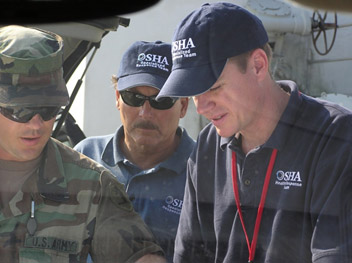
Response organizations (i.e., entities responding to an emergency) typically have ways to protect their workers from foreseeable emergencies. However, some emergencies or disasters overwhelm the safety and health capabilities of response organizations because of the severity of the hazards, the geographic area, and/or the number of workers needed for the response. When large-scale emergencies occur, OSHA can be a critical resource to help response and recovery organizations protect their workers
OSHA's primary authority comes from powers assigned to the Secretary of Labor in the Occupational Safety and Health (OSH) Act of 1970 (Pub. L. 91-596). OSHA standards are codified in various parts of Title 29 of the Code of Federal Regulations. The OSHA Law & Regulations page provides additional information about the OSH Act and OSHA standards.
While the OSH Act itself generally applies to private sector employers, it allows states to assume responsibility for occupational safety and health for private sector employers and workers, as well as state and local employers and workers in the state.
OSHA can be activated by the Department of Homeland Security (DHS) Federal Emergency Management Agency (FEMA) to lead implementation of the National Response Framework (NRF) Worker Safety and Health Support Annex to protect the safety and health of response and recovery workers. Under this Annex, OSHA has the authority to provide technical assistance and support to local, state, federal, tribal, territorial, and insular area agencies.
OSHA and the cooperating agencies listed in the Worker Safety and Health Support Annex can assist such agencies with:
- risk assessment and management
- identification, assessment, and control of health and safety hazards
- development and oversight of health and safety plans (HASPs)
- worker exposure monitoring, sampling, and analysis
- personal protective equipment (PPE) program development and implementation, including monitoring, selection, fit-testing (e.g., for respirators), and decontamination
- incident-specific worker safety and health training
- communication of safety and health information to workers and employers
Under the National Contingency Plan , OSHA, as the Department of Labor's representative on the National Response Team (NRT) and Regional Response Teams (RRT) , provides technical assistance and support, resources, and coordination on preparedness, planning, response and recovery activities for emergencies involving hazardous substances, pollutants and contaminants, oil, and weapons of mass destruction in natural and technological disasters and other environmental incidents of national significance. Section 300.175 of the National Contingency Plan details OSHA's responsibilities under the plan.
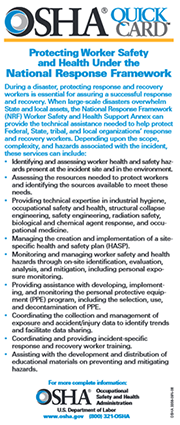
OSHA Resource
The " Emergency Response: Protecting Worker Safety and Health Under the National Response Framework " QuickCard™ describes OSHA's activities during emergency response operations.
As disaster response efforts transition to recovery work, the National Disaster Recovery Framework (NDRF) provides context for how the whole community—including OSHA—works together to restore, redevelop and revitalize the health, social, economic, natural and environmental fabric of the community.
Under the authority of the OSH Act and the other planning frameworks in which it operates, described above, OSHA can provide coordination, technical assistance, and support from the National Office in Washington, DC, regional offices, and area offices across the nation. Additionally, OSHA has a Specialized Response Team (SRT) that maintains and rapidly deploys with special response equipment and incident management skills, and provides technical expertise in worker protection during incidents. Specific technical expertise and support capabilities of the SRT include: toxic chemicals (including chemical warfare agents), biological agents, ionizing and non-ionizing radiation, collapsed structures, demolition, and other construction-type activities.
During disaster response and recovery operations, even when OSHA is operating in a technical assistance and support mode, OSHA standards remain in effect and OSHA retains its ability to enforce the OSHA standards under the OSH Act. Enforcement of OSHA standards follows the jurisdiction in place before the emergency, such as in states operating OSHA-approved occupational safety and health programs called State Plans. There are 28 states and U.S. territories with OSHA State Plans . State Plans have and enforce their own occupational safety and health standards that are required to be at least as effective as OSHA's but may have different or additional requirements. OSHA's federal offices provide coordination, technical assistance, support services, and oversight in all 50 states, U.S. territories, and the District of Columbia.
OSHA's On-site Consultation Program offers free and confidential advice to small and medium-sized businesses in all states across the country, with priority given to high-hazard worksites. On-site Consultation services are separate from enforcement and do not result in penalties or citations. Consultants from state agencies or universities work with employers to identify workplace hazards, provide advice on compliance with OSHA standards, and assist in establishing injury and illness prevention programs. To locate the OSHA On-site Consultation Program nearest you, call 1-800-321-OSHA (3742) or visit OSHA's small business web page .
Additionally, OSHA Compliance Assistance Specialists , located in OSHA area offices throughout the nation, can provide information to workers and employers about OSHA standards, educational programs on specific hazards or OSHA rights and responsibilities, and additional compliance assistance resources. Compliance Assistance Specialists also promote OSHA's training resources and the tools available on the OSHA web site.
Note: This page discusses Personal Protective Equipment (PPE) for emergency response and recovery workers, particularly those responding to natural disaster and chemical (including oil), biological, radiological and nuclear (CBRN) events. The page is not intended to address PPE for all emergency response situations, including certain operations specific to law enforcement, firefighting, and emergency medical personnel.
Introduction to PPE for Emergency Response Workers
Worker exposures to many types of hazards can be prevented or minimized by using engineering controls, administrative controls, and safe work practices. When controls are not feasible, or when such controls are insufficient to reduce worker exposures to certain hazards to or below safe levels (e.g., an OSHA permissible exposure limit [PEL] or other recognized limit), employers must ensure that their workers are provided at no cost and correctly use appropriate PPE. PPE is only one component of a comprehensive worker protection program, and, by itself, does not eliminate a hazard. For PPE to be effective, workers must properly put on, use, and take off appropriate equipment.
Employers of emergency response and recovery workers are responsible for ensuring that their workers have and properly use PPE when necessary. PPE can include respiratory protection, protective clothing, and protective barriers used to protect workers from exposure to chemical (including oil), biological, radiological and nuclear (CBRN) materials and other hazards. The selection of PPE is based on anticipated hazards and PPE selection may need to be modified as a result of monitoring and assessing actual working conditions. In planning for worker PPE needs, employers should consider the full range of a particular hazard a worker may experience (e.g., respirator cartridges suitable for both chemical and particulate exposures even if workers may only need protection from particulates most of the time).
Different types and levels of PPE may be used depending on the specific hazard or hazards present. PPE also may be needed to protect workers from other hazards, such as electric shock hazards or hazards associated with exposures to hazardous substances that may be encountered during emergency response and recovery operations.
The following are some of the important steps employers with emergency response and recovery workers need to take with respect to PPE:
- Conduct a hazard assessment to determine what safety and health hazards workers may encounter;
- Follow the hierarchy of controls—including elimination/substitution and engineering, work practice, and administrative controls—before relying on PPE to protect workers;
- Determine what PPE workers need;
- Provide the proper PPE to workers;
- Train workers in the proper use of PPE, including how to put it on and take it off correctly, and how to clean, maintain and dispose of it after or between uses;
- Ensure that PPE is used properly and whenever necessary;
- Provide medical exams and/or fit testing, as required by OSHA standards, prior to using certain types of PPE (e.g., respirators); and
- Regularly review and update the PPE program as hazards change.
It is crucial that employers plan in advance of an emergency for the PPE needs of their workers. During and immediately after an emergency, there may be limited supplies of PPE available for purchase, so it is important to have the necessary PPE on hand in advance. In an emergency situation, employers may have little or no time to train or fit workers (e.g., perform fit testing for respirators) for certain types of equipment, so it can be critical to have those tasks completed before an emergency occurs.
Selecting PPE for Emergency Response Workers
In selecting PPE for workers, employers should match the PPE to a worker's specific job tasks and working conditions. Select PPE based on a thorough hazard assessment at the worksite. Consider the durability of PPE materials, such as tear resistance and seam strength, in relation to the worker's tasks. Evaluate other aspects of PPE use, including its impact on heat stress, length of time a worker is able to wear a specific combination of equipment, the physical condition of the worker, demands of the specific work activity, and any effects on worker mobility or dexterity. In some cases, layers of PPE may be necessary to provide sufficient protection.
Combinations or ensembles of PPE are classified generally into four levels, ranging from the most protective (Level A) to the least protective (Level D). Each level of PPE, described in the table below and detailed in Appendix B of the Hazardous Waste Operations and Emergency Response (HAZWOPER) standard (29 CFR 1910.120), consists of a combination of protective equipment and clothing that help reduce respiratory, eye, skin, and other types of exposures. The table includes a description of the respiratory protection devices associated with each PPE level. However, respiratory protection also is discussed in greater detail in the "Respiratory Protection" [anchor link to section below] section of this page.
Four Levels of PPE
In addition to items listed in the table above, other types of PPE may be added, including but not limited to eye protection, hearing protection, fall and falling object protection, high visibility clothing, or U.S. Coast Guard-approved personal flotation devices, depending on anticipated hazards and specific worker tasks. OSHA's Safety and Health Topic page on Personal Protective Equipment provides information on PPE for various hazards across a range of industries, and links to relevant OSHA standards and more specific Safety and Health Topics web pages. These pages may help employers and workers identify the types of PPE necessary to prevent and reduce exposure to specific chemical, biological, radiological, electrical, and physical hazards.
Employers should also be familiar with the consensus standards of the National Fire Protection Association (NFPA) and other standards-setting organizations, as these may provide additional recommendations about PPE selection and use.
During an emergency involving a release of a hazardous substance, emergency response workers conducting operations outside of the contaminated areas, but who are anticipated to have contact with contaminated victims, may require Level C or D PPE. PPE selection may depend on a worker's anticipated proximity to the contamination zone perimeter, as well as anticipated contact with other potential sources of contamination (e.g., victims, other workers, or materials and equipment coming from contaminated areas). These workers may include healthcare professionals in hospitals or clinics receiving and treating patients from the site of an emergency or the surrounding contaminated areas. The OSHA Best Practices for Hospital-Based First Receivers of Victims document provides guidance in this area. Appendix B of the HAZWOPER standard ( 29 CFR 1910.120 ) also provides information about PPE levels and compliance with PPE requirements during emergency response operations.
Whenever an emergency event involves environmental contamination, the incident commander or unified command staff should communicate to workers and employers the boundaries between contaminated and uncontaminated areas. Employers should be aware that movement of workers, equipment, and members of the public between contaminated and uncontaminated areas may result in low levels of contamination outside of established boundaries.
Additional resources for assistance with PPE selection include:
- Emergency Response Resources: Personal Protective Equipment . Centers for Disease Control and Prevention (CDC), U.S. Department of Health and Human Services (HHS).
- OSHA/NIOSH Interim Guidance: Chemical, Biological, Radiological, and Nuclear (CBRN) Personal Protective Equipment Selection Matrix for Emergency Responders . Occupational Safety and Health Administration (OSHA), U.S. Department of Labor; and National Institute for Occupational Safety and Health (NIOSH), Centers for Disease Control and Prevention (CDC), U.S. Department of Health and Human Services (HHS).
- Guidance documents for protecting responders . National Personal Protective Technology Laboratory (NPPTL), Centers for Disease Control and Prevention (CDC), U.S. Department of Health and Human Services (HHS).
If workers provide their own protective equipment, employers must ensure that the equipment is adequate to protect the worker from hazards at the worksite and properly used at all times. Employers also must ensure that the equipment is properly maintained and decontaminated after/between use(s). Paragraph (h) of the Respiratory Protection standard ( 29 CFR 1910.134 ) and paragraphs (a) and (b) of the PPE standard ( 29 CFR 1910.132 ) outline this requirement.
Respiratory Protection
Operations that expose workers to harmful levels of particulates, chemical vapors, biological agents, and other airborne contaminants require implementation of a comprehensive respiratory protection program that meets the requirements of the Respiratory Protection standard ( 29 CFR 1910.134 ). Respiratory protection may also be necessary if workers must pass through or may encounter toxic atmospheres (such as dust, mists, gases, or vapors) or oxygen-deficient areas, including while conducting rescue operations and during evacuations. Respiratory protection programs require fit testing and training for workers, medical evaluation and monitoring and selection of appropriate respirators (and cartridges, if required).
Several categories of respiratory protection devices (i.e., respirators) are available to protect workers from inhalation hazards. The table below describes some of these categories.
Use respiratory protection specifically approved by NIOSH for CBRN exposures during such events, if possible. If NIOSH-approved CBRN-specific respirators are not available, the incident commander may allow alternative NIOSH-approved respirators. The table of assigned protection factors (Table 1) of the Respiratory Protection standard (29 CFR 1910.134) may help employers select appropriate respirators for particular operations.
Specifically for CBRN events, there is additional guidance on respiratory requirements in OSHA's Safety and Health Information Bulletin on CBRN Escape Respirators (SHIB 03-08-29 (A). Also, the National Institute for Occupational Safety and Health (NIOSH) has a fact sheet to help respiratory protection program administrators, safety officers, managers, and APR wearers understand the special features of a NIOSH-approved CBRN APR: What's special about Chemical, Biological, Radiological, and Nuclear (CBRN) air-purifying respirators (APR)?
OSHA's Respiratory Protection eTool and Respiratory Protection Safety and Health Topics web page provide additional information about selection and use of various types of air-purifying respirators and other respiratory protection equipment. Several OSHA training videos cover fit testing, maintenance and care, and other important aspects of respiratory protection program management.
Note that surgical masks are not designed or approved for protection against particulates or chemical vapors. In some situations, such as during outbreaks of communicable diseases, surgical masks may help to reduce transmission to other people when worn by infected individuals.
PPE Requirements in OSHA Standards
Emergency responses to hazardous substance releases are covered under OSHA's Hazardous Waste Operations and Emergency Response (HAZWOPER) standard ( 29 CFR 1910.120 ). Recommended PPE in the OSHA/NIOSH PPE Selection Matrix for Emergency Responders is selected to meet the requirements of this standard and Subpart I (Personal Protective Equipment). In order to use the guidance effectively, an employer must assess the risk of a hazardous substance release to the emergency response workers and base PPE selection on that risk.
State Standards
There are 28 OSHA-approved State Plans , operating state-wide occupational safety and health programs. State Plans are required to have standard and enforcement programs that are at least as effective as OSHA's and may have different or more stringent requirements.
Section 5(a)(1) of the Occupational Safety and Health (OSH) Act of 1970 , often referred to as the General Duty Clause, requires employers to "furnish to each of his employees employment and a place of employment which are free from recognized hazards that are causing or are likely to cause death or serious physical harm to his employees." This section may be used to address hazards for which there are no specific standards (e.g., exposure to certain biological or chemical agents).
Paragraph 11(c) of the OSH Act prohibits employers from retaliating against workers for raising concerns about safety and health conditions. OSHA encourages workers who suffer such discrimination to submit a complaint to OSHA . Such complaints must be filed within 30 days.
Depending on the specific work task, setting, and exposure to various hazards, additional OSHA standards may also apply. The list below includes general industry standards that commonly apply to emergency response and recovery operations. However, employers in the construction ( 29 CFR 1926 ); shipyard, maritime, and longshoring ( 29 CFR 1915, 1917, and 1918 ); and agriculture ( 29 CFR 1928 ) industries should be familiar with the OSHA standards that cover their workers, including those for HAZWOPER, PPE, and respiratory protection. In particular, standards for the construction industry are likely to apply during demolition, rebuilding, and other aspects of recovery following a disaster or other emergency event.
General Industry ( 29 CFR 1910 )
- 1910.132 , General requirements [ related topics page ]
- 1910.133 , Eye and face protection [ related topics page ]
- Appendix A , Fit testing procedures (Mandatory)
- Appendix B-1 , User seal check procedures (Mandatory)
- Appendix B-2 , Respiratory cleaning procedures (Mandatory)
- Appendix C , OSHA respirator medical evaluation questionnaire (Mandatory)
- Appendix D , Information for employees using respirators when not required under standard (Mandatory)
- 1910.135 , Occupational head protection
- 1910.136 , Occupational foot protection
- 1910.137 , Electrical protective devices
- 1910.138 , Hand protection
- 1910.141 , Sanitation
- 1910.1000 , Air contaminants (also see related substance-specific standards in 1910 Subpart Z )
- Also see 29 CFR 1904 , Recording and Reporting Occupational Injuries and Illness
- 1910.1030 , Bloodborne pathogens [ related topics page ]
Worker Protection during High-Hazard Emergency Operations
Certain emergency operations may require balancing worker protection with the need to conduct critical missions, such as those necessary for life-saving or critical infrastructure protection. In these instances, an employer should work with the incident commander , unified command staff , and other health and safety personnel to limit worker exposures to all hazards through a combination of engineering and administrative controls and safe work practices, supplemented by PPE.
Emergency response organizations should coordinate with employers in their jurisdictions to ensure they are prepared to respond to and safely perform rescue operations as needed at worksites that may pose unique or particularly hazardous conditions for emergency responders. This may include preparing, training, and exercising capabilities for response and rescue operations at steep angles or heights, such as in pits, tanks, manholes, boilers, furnaces, silos, hoppers, vaults, pipes, ducts, and bins or on slopes, communication towers, or other tall structures, including those under construction; in confined spaces, trenches, or underground; and over, near, or in water of various depths. Such operations may require special engineering and administrative controls, work practices, and PPE to protect emergency response and recovery workers. Employers may need to select and provide workers with, for example, special safety harnesses, ropes or cables, and respirators and cartridges appropriate for the hazards they may encounter. As always, PPE should be used as the final level of protection in the hierarchy of engineering (e.g., ventilating equipment, barriers, shields) and administrative controls and safer work practices.
How to Plan Your Emergency Escape Route

Did you know 50% of homeowners in the U.S. don’t have an emergency escape plan?* In the event of a home safety emergency, every second counts. According to the National Fire Protection Association (NFPA), you may have less than two minutes to escape after your smoke alarms sound. That's why it's important to be prepared by planning and practicing an escape route with the entire family for safe evacuation. By planning, practicing and repeating your emergency escape plan, you can help ensure a safe escape.
Help protect your family by preparing a plan to help them escape to safety in the event of an emergency. The first step in emergency preparedness is to create a home escape plan by downloading and printing our Escape Plan Worksheet . This makes for a fun activity and helps your kids remember how to escape in an emergency if the smoke alarms sound.
Then sit down with your family and draw a map of your home showing the doors and windows in each room. Remember, every room should have at least two emergency exits. When mapping out your family's emergency plan, be sure to also include an outside meeting spot like a tree, light pole or mailbox that is a safe distance away from the house.
After you and your family have created a map, it's time to plan, practice, repeat to ensure everyone is prepared in the event of an emergency!
Having an emergency escape plan is only part of whole home safety. Smoke and carbon monoxide alarms provide you and your family with an early warning, giving you time to safely escape. Learn more about the importance of emergency preparedness and having the necessary fire and carbon monoxide protection throughout your home.
Make an Emergency Escape Plan
- Walk through your home with your family and identify multiple exits out of each room in the house. If windows or doors are blocked, clear them so they can be easily accessed and opened to exit through. It is recommended that you have 2 exit routes from every room in your house.
- For two story houses, consider equipping bedrooms with escape ladders to provide additional, safe evacuation routes.
- When escaping from a business building, employees should follow the escape plan procedures put in place by that business.
- Dedicate someone to assists pets, small children, infants, elderly, or those with disabilities out of the home.
- Assign a meeting spot outside that is a safe distance away from your house like the mailbox, tree or neighbor’s house. It is important that everyone in the household knows where to meet once they get out of the house.
- Ensure your street address is clearly visible on your home or mailbox for emergency first responders.
- If you have children, teach them how to call 9-1-1 once outside at your meeting spot and help them memorize your home address.
Practice Your Emergency Escape Plan
Once you have your emergency escape plan, it’s time to practice the evacuation route. The NFPA recommends executing your emergency escape plan twice a year, as well as at night. It is a good idea to draw a map of your home and plot multiple exits out of every room, so everyone knows the evacuation plan. Knowing you have a safety plan in place in the event of an emergency will not only give you peace of mind, but confidence that your family is prepared. To get started, download our home escape plan worksheet .
If the Smoke Alarms Sound:
Smoke alarms are just as important as your emergency escape route because they alert your family of a potential danger. Install smoke alarms in every bedroom, outside sleeping areas and on each level. Be sure to test them monthly and replace the batteries every six months, or for hassle-free protection, upgrade to 10-year sealed battery alarms to eliminate the need for battery replacements. Remember, you may have less than minutes to escape so plan, practice and repeat your escape route to help protect what matters most.
- Follow your family’s escape plan.
- Get low and crawl under the smoke.
- Close doors behind you as you leave to slow the fire from spreading.
- Once everyone is out, stay out! You should never return into a burning building. Please leave this to the fire fighters and inform them if someone is missing.
- Call 9-1-1 from outside the home.
Other Preventative Safety Measures
Take these preventative safety measures into consideration to help reduce your risk of fire.
- Make sure all kitchen appliances are in proper working order and are unplugged when not in use.
- While you are cooking, never leave the stovetop or oven unattended. A skillet or pot could easily overrun and catch fire.
- Ensure there is nothing surrounding the stove while it is in use, like dish towels or food scraps, as they are potential fire hazards.
- Never leave lit candles or fireplaces unattended. It is important to be present near an open flame.
- Regularly have all vents and furnaces checked to help ensure your home is operating as safely as possible.
- Keep a fire extinguisher on every level of your home. Read the directions to be sure you know how to use it and regularly check it so in the event of a small fire, you have a working fire extinguisher and know how to use it.
*First Alert Consumer Target Identification and Segmentation Report, Insights in Marketing, June 2016
Take the first step toward protecting your home & family
Sign up to learn fire and carbon monoxide safety tips you can practice at home.
Watch CBS News
Containment on Corral Fire increases; evacuations lifted after more than 14,000 acres burned
Updated on: June 5, 2024 / 4:53 PM PDT / CBS/Bay City News Service
TRACY -- Firefighters gained ground on a wind-driven wildfire that scorched thousands of acres 60 miles east of San Francisco, burned down a home and forced residents to flee the area near Tracy .
The fire was 80% contained as of Wednesday, according to Cal Fire, and it had burned 14,168 acres.
Residents were advised to remain vigilant and prepared for potential changes, however.
READ MORE : Fast spread of Corral Fire surprised emergency crews, area residents
Cal Fire said road closures would continue to be enforced for nonresidents on South Corral Hollow Road and Chrisman Road south of Interstate 580.
Interstate 580 between Interstate 5 and Interstate 205 opened up again in both directions after closing due to the blaze, California Highway Patrol said at 7:30 p.m.
The wildfire began Saturday at about 2:30 p.m. east of a Lawrence Livermore Laboratory site in San Joaquin County and reached 14,000 acres by Sunday afternoon.
Residents east of Highway 580 between Corral Hollow Road and South Tracy Boulevard were the first ones told to evacuate by the San Joaquin County Office of Emergency Services.
"Firefighters have made good progress constructing and improving control lines," Cal Fire said on social media Sunday afternoon.

Thousands of people in the area, including parts of the city of Tracy, were ordered to leave for evacuation centers.
Cal Fire Battalion Chief Josh Silveira said Sunday afternoon the fire "burned right up the homes" in the area and destroyed one house. With calmer winds and milder weather Sunday, Silveira said he didn't expect the fire to grow.
Two firefighters suffered minor to moderate burns on Saturday and were expected to make a full recovery, Silveira said.
The wildfire presented no threat to any laboratory facilities or operations and had moved away from the site, Lawrence Livermore spokesperson Paul Rhien said in a statement to the Associated Press early Sunday.
"As a precaution, we have activated our emergency operations center to monitor the situation through the weekend," Rhien said.

Nearly 400 firefighters assisted by air tankers were fighting the fire.
A temporary evacuation point was established at Larch Clover Community Center located at 11157 W Larch Road in Tracy.
The Associated Press contributed to this report.
- California Wildfires
- Alameda County
Featured Local Savings
More from cbs news.

Crystal Fire containment grows overnight in Napa County

Grass fire burns 41 acres on the Altamont, 60 percent contained

4 firefighters hospitalized battling Crystal Fire in St. Helena near Silverado Trail

Grass fire burns near homes west of Brentwood
- International
May 28, 2024 - Israel-Hamas war
By Helen Regan, Heather Chen and Tori B. Powell, CNN
Our live coverage of Israel's war against Hamas in Gaza has moved here .
Nikki Haley writes "Finish them!" on Israeli artillery shells
From CNN's Ebony Davis

Former UN ambassador Nikki Haley wrote “Finish Them!” on Israeli artillery shells during a Memorial Day visit to Israel, according to photos in a post from Danny Danon, a former Israeli ambassador to the United Nations, who accompanied her on the trip.
Her visit to the northern Israeli border came a day after an Israeli strike that killed 45 at a camp for displaced Palestinians in Rafah. Israel’s Prime Minister Benjamin Netanyahu described the strike as "a tragic error ".
Haley's message echoes her previous sentiment during a Fox News interview in which she condemned Hamas’ attacks and called on Netanyahu to “finish them.”
"I will say this to Netanyahu: finish them. Finish them. Hamas did this, you know Iran is behind it, finish them. They should have hell to pay for what they've just done,” Haley said back then.
CNN has reached out to representatives for Haley for comment.
Haley said Tuesday: "1 in 4 of their neighbors were murdered or taken hostage in Gaza. No other country would accept this, Israel should not either."
She also reaffirmed her commitment to Israel, saying during the tour, saying "Don't listen to what is being said in the media. I reassure you: America stands with Israel!"
During the Memorial Day weekend trip, Haley visited Kibbutz Nir Oz, the site of the Nova festival, and Sderot.
She reflected in a social media post about a nurse she met whose “life changed forever’ after October 7.
“Like my daughter, Tali Biner is a nurse in her 20s who loves music and her friends. But, her life changed forever at the Nova Music Festival. For hours she hid, praying not to be next, listening to fellow concert goers beg for mercy as they were raped, genitally mutilated, and shot to death by Hamas,” Haley said.
“When she escaped, she tried to treat victims who were butchered and left to slowly die. Now, she bravely tells her story to bear witness for the hundreds who can’t — raped, tortured, kidnapped, and murdered simply for being Israeli,” she continued.
Algeria draft Security Council resolution calls for ceasefire in Gaza and hostage release, UN diplomat says
From CNN's Richard Roth
Algeria has circulated to all UN Security Council members a proposed draft resolution calling for an immediate ceasefire in Gaza and the unconditional release of all hostages, a UN diplomat told CNN on Tuesday.
It's unknown how the US will vote on this.
Algeria's draft resolution comes after 45 people were killed in an Israeli airstrike on a Rafah camp housing displaced people on Sunday.
Houthi ballistic missiles strike Greek-owned ship in Red Sea, US military says
A Greek owned and operated merchant ship in the Red Sea reported being struck by three anti-ship ballistic missiles launched Tuesday by Iranian-backed Houthis in Yemen, according to US Central Command.
Merchant Vessel Laax continued on its voyage and there were no injuries reported, CENTCOM said in a statement.
During the same time, US forces destroyed five Houthi drones over the Red Sea that were launched from a Houthi-controlled area of Yemen and “presented an imminent threat to merchant vessels in the region,” the statement added.
Nearly 1 million Palestinians displaced from Rafah, UN officials say. Here's what you should know
From CNN staff
At least 940,000 people have been displaced from Rafah in the past three weeks as a result of "the intensification of hostilities and issuance of evacuation orders" by Israeli forces, according to the UN Office for the Coordination of Humanitarian Affairs (UNOCHA).
Many of the displaced Palestinians are attempting to evacuate following devastating Israeli strikes – but they don't know where to go.
Here are more headlines you should know:
More on the Rafah strike:
- The Israeli military is looking into the possibility that the Israeli airstrike, which killed more than 45 people on Sunday, may have unintentionally set off possible stored weapons in a nearby compound and a large fire that decimated part of a camp housing displaced Palestinians, according to spokesperson Rear Admiral Daniel Hagari.
- A CNN analysis of videos and a review by explosive weapons experts found that US-made munitions were used in the strike.
- The United States “ will be watching ” the results of the Israeli investigation, said State Department spokesperson Matthew Miller. He added that the findings should be “presented openly and transparently to us and to the world.”
- White House National Security Council spokesperson John Kirby told reporters Tuesday that Sunday’s airstrike did not cross President Joe Biden's red line. Kirby said he had “no policy changes to speak to” when asked if this strike would change policy – but emphasized that this strike “just happened.”
International reaction to the Rafah strike:
- French UN Ambassador Nicolas de Rivière warned of any further escalations in Rafah, saying "it is high time," for the UN Security Council "to take action and to adopt a new resolution" about the war in Gaza.
- Protesters in cities across Europe gathered to voice opposition to the deadly strike in southern Gaza.
Other Israeli attacks:
- The Israeli military killed at least 29 Palestinians in two separate attacks around Rafah, according to Gaza’s Ministry of Health and the Emergency Committee of the Rafah Governorate. UNRWA Commissioner-General Philippe Lazzarini said his staff are "terrified" and are packing up and moving following the strikes.
Broken pier:
- The temporary pier constructed by the US military to transport aid into Gaza broke apart in heavy seas on Tuesday in a major blow to the American-led effort to create a maritime corridor for humanitarian supplies into the war-torn enclave, according to four US officials. An effort to reassemble the causeway and connect it to the parking area will resume when sea conditions allow, officials said.
US-made munitions were used in deadly strike on Rafah tent camp, CNN analysis shows
From CNN’s Allegra Goodwin and Avery Schmitz
US-made munitions were used in a deadly Israeli strike on a camp for displaced Palestinians in Rafah, a CNN analysis of video from the scene and a review by explosive weapons experts found.
CNN geolocated videos showing tents in flames in the aftermath of the strike on the camp for internally displaced people (IDPs) known as "Kuwait Peace Camp 1."
In video shared on social media, which CNN geolocated to the same scene by matching details including the camp’s entrance sign and the tiles on the ground, the tail of a US-made GBU-39 small-diameter bomb (SDB) is visible, according to four explosive weapons experts who reviewed the video for CNN.
The GBU-39, manufactured by Boeing, is a high-precision munition “designed to attack strategically important point targets,” and result in low collateral damage, explosive weapons expert Chris Cobb-Smith told CNN.
However, “using any munition, even of this size, will always incur risks in a densely populated area,” said Cobb-Smith, a former British Army artillery officer.
Trevor Ball, a former US Army senior explosive ordnance disposal team member who also identified the fragment as being from a GBU-39, explained to CNN how he drew his conclusion.
“The warhead portion [of the munition] is distinct, and the guidance and wing section is extremely unique compared to other munitions. Guidance and wing sections of munitions are often the remnants left over even after a munition detonates. I saw the tail actuation section and instantly knew it was one of the SDB/GBU-39 variants.”
CNN’s identification of the munition is consistent with a claim made by Israel Defense Forces spokesperson Rear Admiral Daniel Hagari in a briefing about the tragedy on Tuesday. Hagari said the strike – which he said targeted senior Hamas commanders – used two munitions with small warheads containing 17 kilos of explosives, adding these bombs were "the smallest munitions that our jets could use.”
The traditional GBU-39 warhead has an explosive payload of 17 kilos.
Additionally, serial numbers on the remnants match those for a manufacturer of GBU-39 parts based in California – more evidence the bombs were made in the US.
The Pentagon declined to comment and referred CNN to comments from Israel on its operation. CNN has also reached out to the US National Security Council.
Read the full story.
French UN ambassador calls on UN Security Council "to take action and to adopt a new resolution"
From CNN's Richard Roth and Mohammed Tawfeeq

French UN Ambassador Nicolas de Rivière warned of any further escalations in Rafah, saying "it is high time," for the UN Security Council (UNSC) "to take action and to adopt a new resolution" about the war in Gaza.
"There must be an immediate ceasefire in Gaza and the unconditional release of the hostages. There is no safe zone for Palestinian civilians in Rafah," Rivière said in a statement Tuesday.
He added that the Security Council "must fulfill its mandate and take action now,"
"It must allow the UN to play its full role in the Gaza Strip, in order to cover the immediate needs of the population," he said.
"France will remain committed to building a state for the Palestinians and security guarantees for Israel," Rivière added.
Doctor describes sleepless nights and "very miserable" situation in Rafah
From CNN's Sarah EL Sirgany and Mohammed Tawfeeq
The situation in Rafah is "very miserable," according to a doctor currently working in the southern Gaza city.
"All night, we couldn't sleep," Dr. Safa Jaber told Doctors Without Borders, known by its French acronym MSF (Médecins Sans Frontières), in an Arabic audio message shared by t he group on X with English subtitles .
"All night we heard the clashes, the bombings and the sound of the rockets. Nobody knows what is happening exactly. There are clashes in two different locations in Tal al-Sultan area, in the north and the south," Jaber said. "I am speechless, I cannot even describe what is happening. We are scared for ourselves and for our children. We are not expecting this to happen so suddenly," she added. "Everyone is very terrified. Where shall we go? We are heading to the so-called safe zone. But there is no safe space here after what happened the day before yesterday with the burning of tents," she explained. "We are forced to stay in tents where we will be exposed to the heat, sand. We have to struggle to find water every day; both clean and salt water; the basic services that every human being needs to stay alive. The situation is very miserable," Jaber added.
"There is no shelter, no life, no future." Displaced Palestinians in Rafah wonder where they must move next
From Mohammed Al-Sawalhi, Sarah El Sirgany and Abeer Salman and Hira Humayun

Displaced Palestinians are attempting to evacuate following devastating Israeli strikes in southern Gaza – but they don't know where to go.
Speaking to a CNN stringer in Khan Younis, north of Rafah, people said they did not know where else to go, as they tried to head north toward Deir El-Balah in central Gaza.
Video from the stringer shows mattresses, wooden panels, chairs, and various other belongings piled on top of vehicles and donkey carts.
"What’s happening now, whether in Rafah, Khan Younis or Gaza in general, is the disastrous displacement of people. There is no shelter, no life, no future," said Ansar Mahdi, who said she's been displaced four times. "The displacement is repugnant. When people move from one place to another, they want to live.They need money. They’ve lost their savings," she said. "They told us to move from the north to the south. We did. We stayed in tents in abysmal conditions. No words can convey what we went through," she added. "Where else can we go? Where the next displacement would be?" Mahdi asked.
The roads, lined by tents and piles of garbage, were busy with people and vehicles moving in search of empty spaces.
Walking on crutches, Mohamed Jarbou, said, "The elderly have been humiliated. Children humiliated. What’s wrong? They are all civilians. The resistance is not here. The resistance is fighting somewhere else. We are displaced. Why are you hitting the displaced people?"
Israeli strikes over the past two days in Rafah have forced the already displaced people to flee.
More than two dozen people were killed in Israel strikes on two camps on Tuesday, according to Palestinian officials.
The Israeli military denied striking a humanitarian area in Al-Mawasi, telling CNN, "Contrary to the reports from the last few hours, the IDF did not strike in the Humanitarian Area in Al-Mawasi.”
CNN has asked if the military struck elsewhere in Al-Mawasi, and for comment on a strike that hit the Tal al-Sultan camp .
Please enable JavaScript for a better experience.
Corral Fire: Evacuation orders downgraded in Tracy. What to know to stay safe.
California firefighters are battling the fast-moving Corral Fire that started on Saturday near the Lawrence Livermore National Laboratory Site 300 and within a few hours blew up to more than 10,000 acres. It is threatening areas southwest of Tracy.
The California Department of Forestry and Fire Protection does not yet know what caused the fire.
The San Joaquin County Office of Emergency Services' evacuation order is being downgraded to a warning on Sunday evening southwest of Tracy as crews fighting the Corral Fire strengthen containment lines.
The evacuation warning goes into effect at 6 p.m. and essentially means residents who were forced to evacuate on Saturday should stay vigilant and prepared to leave again if the situation changes and authorities have to order everyone out for safety reasons.
The following areas had been ordered to evacuate:
- West of the California Aqueduct
- South of Corral Hollow Creek
- West to Alameda County and South to Stanislaus County
Shelters had been set up for people and their animals in the following locations:
- A temporary evacuation point is at Larch Clover Community Center, 11157 W. Larch Road in Tracy.
- A large animal shelter is at the Manteca Unified School District, 2271 W. Louise Ave. in Manteca.
What to know about the Corral Fire
The Corral Fire was reported at 2:39 p.m. off West Corral Hollow in San Joaquin County.
The fire has consumed 14,168 acres near Lawrence Livermore National Laboratory Site 300, southwest of Tracy, and is 50% contained, according to the California Department of Forestry and Fire Protection on Sunday night.
The cause of the fire is unknown and remains under investigation.
How to sign up for emergency alerts
To sign up for the San Joaquin County emergency alert system, residents can go to San Joaquin County Office of Emergency Services' website, sjready.org , to register for the system.
Residents can also view the latest information on evacuation orders and evacuation maps on the website.
Preparing for wildfire evacuations
If residents have time before evacuating, Cal Fire suggests the following steps to give their homes the best chance of surviving the wildfire:
Inside the house
- Pack your ‘go bag’ or emergency kit , and have it ready to grab.
- Check that your wildfire action plan is up-to-date.
- Know your community’s emergency plan, evacuation routes, and destinations.
- Close all windows and doors, but leave them unlocked.
- Take down flammable window treatments like shades and curtains, and close metal shutters.
- Clear away light curtains.
- Move anything that burns easily to the middle of rooms, away from windows and doors.
- Turn off the gas at the meter and pilot lights.
- Leave lights on for firefighters to see your house in smoke.
- Switch off the air conditioning.
Outside the house
- Bring in flammable items from outside, like patio furniture, toys, doormats, and trash bins. Alternatively, place them in your pool.
- Shut off propane tanks.
- Move grills and other propane BBQ appliances away from the house.
- Attach garden hoses to outside taps for firefighter use and fill buckets with water to scatter around.
- Don’t leave sprinklers or water running as it can lower critical water pressure.
- Keep exterior lights on to make your home visible in smoky or dark conditions.
- Put your emergency kit in your car.
- Park your car in the driveway, facing outwards, loaded and ready, with all doors and windows shut.
- Have a ladder handy for firefighter roof access.
- Seal attic and ground vents with plywood or commercial seals.
- Keep an eye on the fire situation and don’t wait for an evacuation order if you feel at risk.
- Check with neighbors to ensure they’re also prepared.
Record reporter Hannah Workman covers news in Stockton and San Joaquin County. She can be reached at [email protected] or on Twitter @byhannahworkman. Support local news, subscribe to The Stockton Record at https://www.recordnet.com/subscribenow .
Taylor Swift pauses Scotland Eras Tour show until 'the people in front of me get help'

Taylor Swift 's acoustic set had some challenges on night one in Edinburgh, Scotland , and the Eras Tour star was not shy to pause her set.
During the second chorus of "Would've, Could've, Should've" from "Midnights," she strummed her guitar and asked security guards to help a fan, who seemed to need help.
"I’m just gonna keep playing until someone notices them," she said in a talk-sing voice for about a minute. "We’re going to keep talking until the people in front of me get help."
"I can do this all night," she added.
When the fan received attention from a medical team, and Swift heard they were OK, she said "Awesome." She mashed up "I Know Places" from "1989 (Taylor's Version)."
Need a break? Play the USA TODAY Daily Crossword Puzzle.
"'Tis The Damn Season" from "Evermore," which was cut from year two of the tour returned during the piano song. She mashed up "Daylight" from "Lover."
Don't miss any Taylor Swift news; sign up for the free, weekly newsletter This Swift Beat.
Follow Taylor Swift reporter Bryan West on Instagram , TikTok and X as @BryanWestTV .
ELECTROSTAL HISTORY AND ART MUSEUM (2024) All You Need to Know BEFORE You Go (with Photos)
Corral Fire Status Update Reports
- Update as of June 6, 2024 at 6:02 PM
- Update as of June 6, 2024 at 8:05 AM
- Update as of June 5, 2024 at 6:08 PM
- Update as of June 5, 2024 at 7:32 AM
- Update as of June 4, 2024 at 9:06 PM
- Update as of June 4, 2024 at 8:09 PM
- Update as of June 4, 2024 at 6:19 PM
- Update as of June 4, 2024 at 11:28 AM
- Update as of June 4, 2024 at 10:09 AM
- Update as of June 4, 2024 at 7:32 AM
- Update as of June 3, 2024 at 7:23 AM
- Update as of June 2, 2024 at 6:52 PM
- Update as of June 2, 2024 at 3:27 PM
- Update as of June 2, 2024 at 1:35 PM
- Update as of June 2, 2024 at 12:42 PM
- Update as of June 2, 2024 at 7:57 AM
- Update as of June 2, 2024 at 7:50 AM
- Update as of June 1, 2024 at 10:47 PM
- Update as of June 1, 2024 at 9:46 PM
- Update as of June 1, 2024 at 9:13 PM
- Update as of June 1, 2024 at 9:01 PM
- Update as of June 1, 2024 at 7:50 PM
- Update as of June 1, 2024 at 7:35 PM
- Update as of June 1, 2024 at 5:33 PM
- Update as of June 1, 2024 at 4:45 PM
- Update as of June 1, 2024 at 4:44 PM
We've detected unusual activity from your computer network
To continue, please click the box below to let us know you're not a robot.
Why did this happen?
Please make sure your browser supports JavaScript and cookies and that you are not blocking them from loading. For more information you can review our Terms of Service and Cookie Policy .
For inquiries related to this message please contact our support team and provide the reference ID below.
Security Alert May 17, 2024
Worldwide caution, update may 10, 2024, information for u.s. citizens in the middle east.
- Travel Advisories |
- Contact Us |
- MyTravelGov |
Find U.S. Embassies & Consulates
Travel.state.gov, congressional liaison, special issuance agency, u.s. passports, international travel, intercountry adoption, international parental child abduction, records and authentications, popular links, travel advisories, mytravelgov, stay connected, legal resources, legal information, info for u.s. law enforcement.
Replace or Certify Documents
Share this page:
Latest Information for U.S. Citizens
Information for U.S. Citizens in Israel, the West Bank, and Gaza
The Department reminds U.S. citizens of the continued need for caution and increased personal security awareness as security incidents often take place without warning. The security environment remains complex and can change quickly depending on the political situation and recent events. Please see the latest Israel Security Alert .
U.S. citizens should heed the Travel Advisory for Israel, the West Bank, and Gaza. The U.S. Embassy continues to closely monitor the dynamic security situation in Israel, the West Bank, and Gaza. There are active military operations and active rocket and mortar fire in Gaza and the Gaza periphery. Terrorist groups, lone-actor terrorists and other violent extremists continue plotting possible attacks in Israel, the West Bank, and Gaza. Terrorists and violent extremists may attack with little or no warning, targeting tourist locations, transportation hubs, markets/shopping malls, and local government facilities. Violence can occur in Israel, the West Bank, and Gaza without warning. If you require emergency assistance while in Israel, the West Bank or Gaza, contact the U.S. Embassy in Jerusalem by email ( [email protected] for those in Jerusalem, the West Bank, and Gaza or [email protected] for those in Israel outside of Jerusaleml).
Individuals seeking to depart Gaza: As of May 7, the Israel Defense Forces control the Gaza side of the Rafah Crossing. Since that day, the Rafah Crossing between Egypt and Gaza has remained closed. As soon as the U.S. Embassy in Jerusalem receives information regarding new exit procedures from Gaza to Egypt, including when crossings resume, we will communicate this to the public immediately.
This remains a complex situation with serious implications for the safety and security of U.S. citizens. U.S. citizens in Gaza in need of assistance should contact [email protected] . U.S. citizens in Gaza are reminded that the U.S. government is unable to provide routine or emergency consular services to U.S. citizens in Gaza as U.S. government employees are prohibited from traveling there.
The U.S. government does not control who is permitted to depart Gaza or enter Egypt. Individuals must assess their own safety and risks in attempting to cross the border. Individuals permitted to enter Egypt will likely receive a 72-hour Egyptian visa; all those who cross should have a plan for onward travel from Egypt in this timeframe. U.S. citizens, LPRs and their immediate family members who successfully enter Egypt and require further consular assistance should contact the U.S. Embassy in Cairo via the U.S. Citizens Services Navigator . Individuals may apply for a U.S. visa at any U.S. Embassy or Consulate; U.S. immigration laws and regulations will apply.
We continue to work in partnership with Egypt and Israel towards safe passage for U.S. citizens, LPRs, and their immediate family members.
Immediate family members of U.S. citizens include:
- unmarried children under the age of 21, and
- parents of U.S. citizens.
If the U.S. citizen is under 21, immediate family will also include any siblings who are also unmarried and under 21.
Immediate family members of LPRs include:
- unmarried children under 21 years of age.
Enroll in STEP

Subscribe to get up-to-date safety and security information and help us reach you in an emergency abroad.
Recommended Web Browsers: Microsoft Edge or Google Chrome.
Make two copies of all of your travel documents in case of emergency, and leave one with a trusted friend or relative.
External Link
You are about to leave travel.state.gov for an external website that is not maintained by the U.S. Department of State.
Links to external websites are provided as a convenience and should not be construed as an endorsement by the U.S. Department of State of the views or products contained therein. If you wish to remain on travel.state.gov, click the "cancel" message.
You are about to visit:
Large fire near Spain's Ibiza airport causes flight delays and warehouse evacuation
Some flights were delayed at the airport in Ibiza following a huge fire in a nearby warehouse.
Wednesday 5 June 2024 09:47, UK
- Fire Service
Please use Chrome browser for a more accessible video player

Hostage reunited with father

New CCTV of missing TV doctor

'NHS failed me time and time again'

Taylor Swift kicks off UK leg of Eras tour

Watch PM berated by angry GP

IMAGES
VIDEO
COMMENTS
Fire Evac Tour 2024. Come progettare un sistema di rivelazione e segnalazione allarme incendio in conformità alle normative vigenti. Un caso pratico. Nel corso del primo semestre 2024, Beta Cavi e Bosch Security Systems, saranno nuovamente sponsor nel consueto appuntamento di formazione e divulgazione delle normative antincendio.
Share your videos with friends, family, and the world
The Fire Evac Tour, which featured the industry's latest innovations, made six stops throughout the Italian peninsula and was an enormous success in 2013. S News has therefore decided to offer a special event: a summary of the contents, including the regulatory and technical aspects, as well as the products and processes.
We are close to the launch of the Fire Evac Tour 2024, a traveling event dedicated to the design of fire prevention and voice evacuation systems which brings with it great news. An event out of ...
"Fire Evac Tour 2024: Un'esperienza totalmente immersiva nel progetto" L'evento, a carattere gratuito, si terrà a partire dalle ore 9.30 del 13 marzo 2024 presso CNOS-FAP Torino Valdocco (Via Maria Ausiliatrice, 36 - Torino ).
Seminari Fire Evac Tour 2024: LECCE, 9 aprile 2024 ARTHOTEL & PARK LECCE via G. De Chirico, 1 - Uscita 10 tang.est/ovest, Lecce ore 14.00-19.00 Programma FIRE EVAC TOUR Lecce BARI, 10 aprile 2024 PARCO DEI PRINCIPI - HOTEL CONGRESS & SPA Via Vito Vasile, prolungamento Viale Europa 6 - Bari (BA) ore 14.00-19.00 Programma ...
Fire Evac Tour Evo is the event dedicated to fire prevention. During the first quarter of 2016, Beta Cavi and Bosch Security Systems will once again be sponsors for the customary fire prevention training and awareness event. The 2016 edition of FIRE EVAC TOUR EVO was conceived to remove any possible doubt on designing fire prevention systems but this time with the help of multimedia systems.
The Corral Fire began in the City of Tracy around 2:30 p.m. and had consumed 14,000 acres as of Sunday evening, according to the California Department of Forestry and Fire Protection. The flames ...
About Press Copyright Contact us Creators Advertise Developers Terms Privacy Policy & Safety How YouTube works Test new features NFL Sunday Ticket Press Copyright ...
Authorities lifted evacuation orders for the Simmons Fire on Friday morning, three days after residents near the wildfire were told to leave their homes. The wildfire started about 4½ miles ...
Inviting external emergency responders to tour the facility to learn about hazards, the facility's processes, protective features and systems, and proper actions to take (or not to take) during emergencies. ... The emergency evacuation plan should identify the different types of situations that will require an evacuation of the workplace. As ...
Exactly what you'd pay for emergency evacuation would depend on your medical condition, the care required and your location. Durazo says emergency medical transportation to the U.S. from the ...
Fire Evac Tour 2017. Fire Evac Tour 2017. Open full screen to view more. This map was created by a user. Learn how to create your own. ...
Make an Emergency Escape Plan. Walk through your home with your family and identify multiple exits out of each room in the house. If windows or doors are blocked, clear them so they can be easily accessed and opened to exit through. It is recommended that you have 2 exit routes from every room in your house.
Evacuation orders in the area of the Corral Fire near Tracy were reduced to warnings as of 6 p.m. Sunday as the fire held at 14,168 acres. The fire was 75% contained as of Monday morning ...
Fire officials reported a large fire at 2:30 p.m. on the north side of Corral Hollow Road east of Interstate 580, near Lawrence Livermore Lab Site 300, located southwest of Tracy. At 5:50 p.m. on ...
Our live coverage of Israel's war against Hamas in Gaza has moved here. 11:05 p.m. ET, May 28, 2024. Nikki Haley writes "Finish them!" on Israeli artillery shells. From CNN's Ebony Davis. Nikki ...
The Corral Fire was reported at 2:39 p.m. off West Corral Hollow in San Joaquin County. The fire has consumed 14,168 acres near Lawrence Livermore National Laboratory Site 300, southwest of Tracy ...
Evacuation Orders for Genasys Zones KRN-719, 720 and 724-A have been LIFTED. The evacuation order for Genasys Protect Zone KRN-724-B has been downgraded to an Evacuation WARNING. The situation can change very quickly and visibility in the area may be reduced with roads being blocked.
USA TODAY NETWORK. 0:04. 0:59. Taylor Swift 's acoustic set had some challenges on night one in Edinburgh, Scotland, and the Eras Tour star was not shy to pause her set. During the second chorus ...
Art MuseumsHistory Museums. Write a review. Full view. All photos (22) Suggest edits to improve what we show. Improve this listing. Revenue impacts the experiences featured on this page, learn more. The area. Nikolaeva ul., d. 30A, Elektrostal 144003 Russia.
Corral Fire Status Update Reports. Update as of June 6, 2024 at 8:05 AM. Update as of June 5, 2024 at 6:08 PM. Update as of June 5, 2024 at 7:32 AM. Update as of June 4, 2024 at 9:06 PM. Update as of June 4, 2024 at 8:09 PM. Update as of June 4, 2024 at 6:19 PM. Update as of June 4, 2024 at 11:28 AM.
June 3, 2024 at 5:24 PM PDT. Listen. 1:00. An active volcano in central Philippines erupted Monday night, prompting a mandatory evacuation of residents near the area and the cancellation of some ...
Mon, 06/03/2024. COLUMBIA — The South Carolina Department of Public Safety and the South Carolina Department of Transportation, along with partners from the South Carolina Emergency Management Division and other state and local agencies, will conduct a full-scale hurricane evacuation exercise on Wednesday, June 5, to test lane reversal plans ...
Please see the latest Israel Security Alert. U.S. citizens should heed the Travel Advisory for Israel, the West Bank, and Gaza. The U.S. Embassy continues to closely monitor the dynamic security situation in Israel, the West Bank, and Gaza. There are active military operations and active rocket and mortar fire in Gaza and the Gaza periphery.
Large fire near Spain's Ibiza airport causes flight delays and warehouse evacuation. Some flights were delayed at the airport in Ibiza following a huge fire in a nearby warehouse.